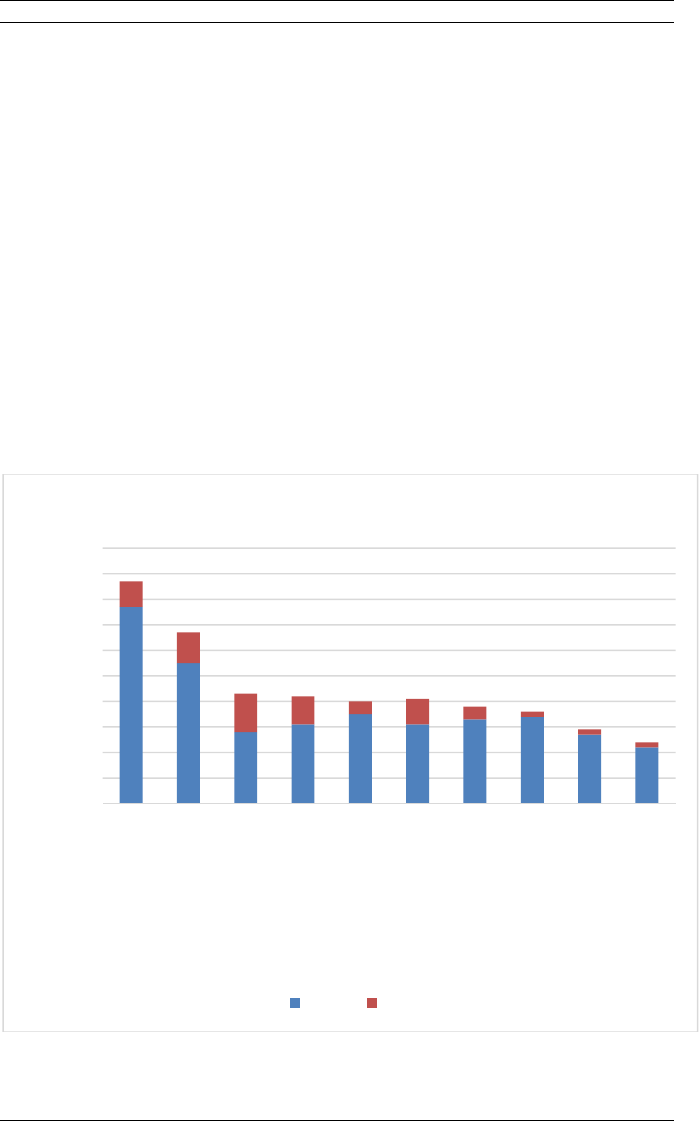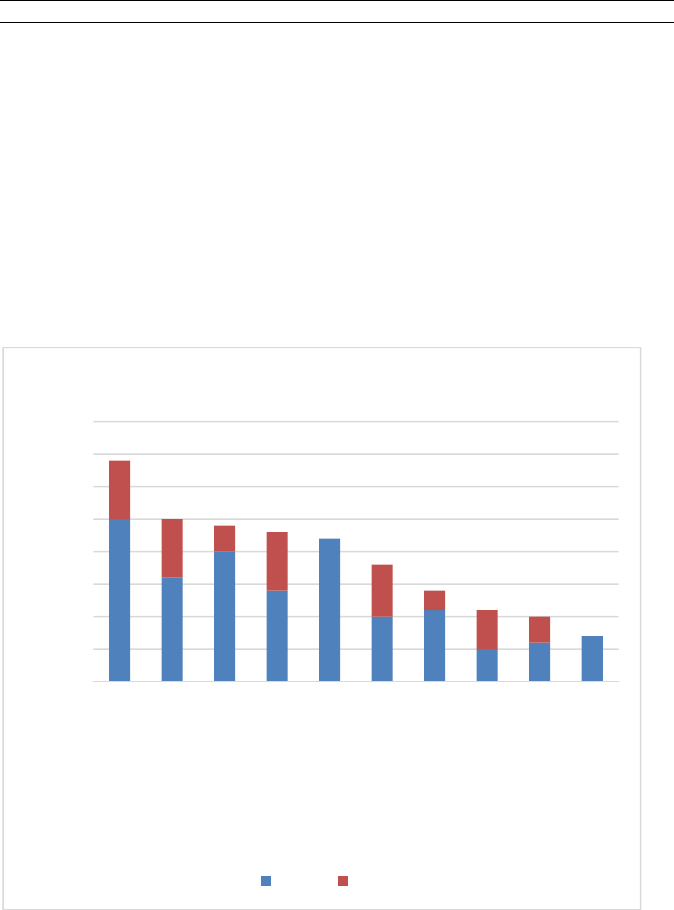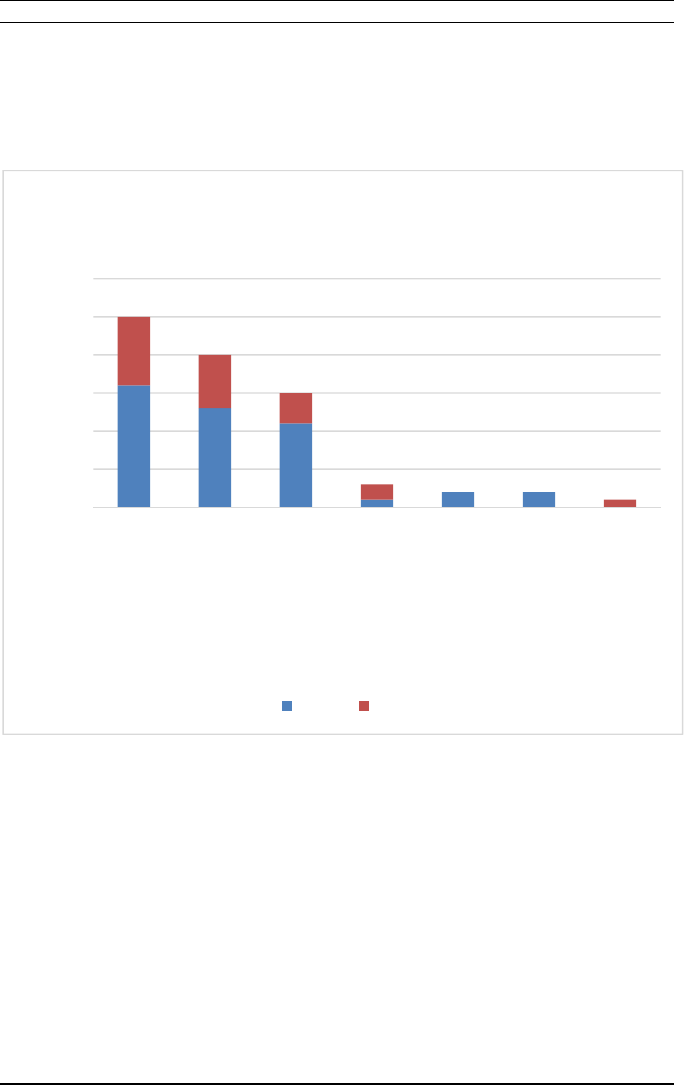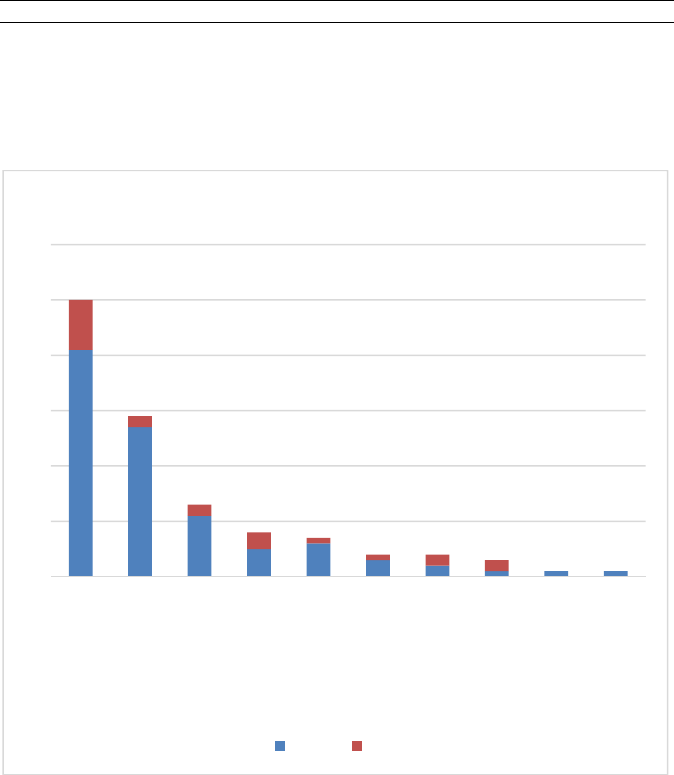
Hastings Journal of Crime and Punishment Hastings Journal of Crime and Punishment
Volume 1
Number 1
Winter 2020
Article 4
Winter 2020
After Abolition: Acquiescence, Backlash, and the Consequences After Abolition: Acquiescence, Backlash, and the Consequences
of Ending the Death Penalty of Ending the Death Penalty
Austin Sarat
Charlotte Blackman
Elinor Scout Boynton
Katherine Chen
Theodore Perez
Follow this and additional works at: https://repository.uchastings.edu/
hastings_journal_crime_punishment
Part of the Criminal Law Commons, and the Criminal Procedure Commons
Recommended Citation Recommended Citation
Austin Sarat, Charlotte Blackman, Elinor Scout Boynton, Katherine Chen, and Theodore Perez,
After
Abolition: Acquiescence, Backlash, and the Consequences of Ending the Death Penalty
, 1 HASTINGS BUS
L.J. 33 (2020).
Available at: https://repository.uchastings.edu/hastings_journal_crime_punishment/vol1/iss1/4
This Article is brought to you for free and open access by the Law Journals at UC Hastings Scholarship Repository.
It has been accepted for inclusion in Hastings Journal of Crime and Punishment by an authorized editor of UC
Hastings Scholarship Repository. For more information, please contact [email protected].

3 - Sarat_etal__HJCP1-1.docx 12/6/2019 10:10 AM
33
After Abolition: Acquiescence, Backlash,
and the Consequences of Ending the
Death Penalty
AUSTIN SARAT, CHARLOTTE BLACKMAN, ELINOR SCOUT BOYNTON,
KATHERINE CHEN, AND THEODORE PEREZ
*
Introduction
The period from 2007 to 2019 was one of the most successful in the
modern history of death penalty abolitionism.
1
In that time, ten states
abolished capital punishment. Seven did so through the legislative process,
while the other three ended the death penalty through a court decision.
2
In
one of those states in Nebraska, legislative abolition was reversed by a
referendum vote.
3
Nebraska stands out as a vivid example of what scholars
* Austin D. Sarat is the Associate Dean of Faculty and William Nelson Cromwell Professor
of Jurisprudence and Political Science at Amherst College. A leader in the scholarship of
death penalty, Professor Sarat has authored or edited over 90 books. He is the author of The
Death Penalty on the Ballot: American Democracy and the Fate of Capital Punishment
(2019), Mercy on Trial: What It Means to Stop an Execution (2005) and the co-author of
Gruesome Spectacles: Botched Executions and America’s Death Penalty (2014); Charlotte
Blackman, Amherst College ’20; Elinor Scout Boynton, Amherst College ’20; Katherine
Chen, Amherst College ’19; Theodore Perez, Amherst College ’20.
1. See generally Wayne A. Logan, Casting New Light on an Old Subject: Death
Penalty Abolitionism for a New Millennium, 100 M
ICH. L. REV. 1336, 1336-79 (2002);
Gretchen Frazee, How States Are Slowly Getting Rid of the Death Penalty, PBS
NEWS HOUR
(Mar. 13, 2019), https://www.pbs.org/newshour/nation/how-states-are-slowly-getting-rid-of-
the-death-penalty; S
TUART BANNER, THE DEATH PENALTY: AN AMERICAN HISTORY (Harvard
Univ. Press 2003).
2. State by State, D
EATH PENALTY INFORMATION CENTER (2019), https://deathpenalty
info.org/state-and-federal-info/state-by-state. The states ending capital punishment after
2007 were: New York, New Jersey, New Mexico, Illinois, Connecticut, Maryland,
Nebraska, Delaware, Washington, and New Hampshire.
3. A
USTIN SARAT, THE DEATH PENALTY ON THE BALLOT: AMERICAN DEMOCRACY AND
THE
FATE OF CAPITAL PUNISHMENT 86-87 (Cambridge Univ. Press 2019); see also Harry
Bruinius, In Nebraska Vote, Sign of Broader Conservative Backlash to Death Penalty,
CHRISTIAN SCIENCE MONITOR (May 28, 2015), https://www.csmonitor.com/USA/Politics/
2015/0528/In-Nebraska-vote-sign-of-broader-conservative-backlash-to-death-penalty.

3 - Sarat_etal__HJCP1-1.docx 12/6/2019 10:10 AM
34 Hastings Journal of Crime and Punishment [Vol. 1:1
have labelled “backlash”: a strong political and legal reaction in opposition
to a controversial decision.
4
The Death Penalty and Backlash
Abolitionists had good reason to fear such a reaction given what
happened several decades earlier in the wake of the United States Supreme
Court’s 1972 decision in Furman v. Georgia,
5
which declared the death
penalty unconstitutional because of the arbitrary and discriminatory manner
in which it was applied.
6
At the time, some abolitionists thought Furman
marked the end of the capital punishment in the United States.
7
As Jack
Greenberg of the National Association for the Advancement of Colored
People (NAACP) Legal Defense and Education Fund (LDF) stated that
“there will no longer be any more capital punishment in the United
States.”
8
Another commentator suggested that “[t]he Supreme Court
decision outlawing the death penalty as it is now imposed leaves the door
open for Congress or the states to write new laws that would be considered
valid. “But the door isn’t open very much.”
9
However, such predictions were quickly proven wrong.
10
Maurice
Chammah of the Marshal Project reports that “[t]he backlash to Furman
was swift and furious, as state legislatures scrambled to rewrite their laws
to satisfy the [C]ourt’s concern that the punishment was arbitrary.”
11
It was
only a matter of days after the Court’s decision before five states
4. Michael Klarman describes what he believes to be the paradigmatic example of
backlash in the reaction to Brown v. Board of Education. “Race,” Klarman argues, “became
the decisive focus of southern politics, and massive resistance its dominant theme.” See
generally Michael J. Klarman, How Brown Changed Race Relations: The Backlash Thesis,
1 J. OF AM. HIST. 81, 81-118 (1994).
5. Furman v. Georgia, 408 U.S. 238, 239-40, 256-57 (1972).
6. Daniel D. Polsby, The Death of Capital Punishment? Furman v. Georgia, 1972 S
UP.
CT. REV. 1, 1-40 (1972).
7. See generally Hugo Adam Bedau, The Case Against the Death Penalty, Capital
Punishment Project (American Civil Liberties Union, 1992); see also B
ANNER, supra note 1,
at 231-66.
8. M
ICHAEL MELTSNER, CRUEL AND UNUSUAL: THE SUPREME COURT AND CAPITAL
PUNISHMENT 215 (Quid Pro Books 2011).
9. Barry Schweid, New Laws Unlikely on Death Penalty, THE FREE LANCE-STAR (June
30, 1972), https://news.google.com/newspapers?id=pAoQAAAAIBAJ&sjid=2YoDAAAAI
BAJ&pg=3786,38609&hl=en.
10. Banner, supra note 1, at 231-66.
11. Maurice Chammah, The Odds of Overturning the Death Penalty, T
HE MARSHALL
PROJECT (Nov. 16, 2015), https://www.themarshallproject.org/2015/11/16/the-odds-of-over
turning-the-death-penalty.

3 - Sarat_etal__HJCP1-1.docx 12/6/2019 10:10 AM
Winter 2020] After Abolition 35
announced that they intended to reinstate the death penalty.
12
As renowned
death-penalty scholars Carol S. Steiker and Jordan M. Steiker note, “The
backlash in the early 1970s depended largely on the view that new energy
and attention to the death penalty could rescue it from its manifest and
manifold problems.”
13
By May 1973, thirteen states had reinstated the
death penalty and by 1976 that number increased to thirty-five.
14
The adverse reaction to Furman was also reflected in public opinion.
Three months before the decision, 42% of Americans said they were
opposed to the death penalty. Four months after Furman, opposition to the
death penalty had fallen to 32%.
15
By 1976, death penalty support reached
a twenty-five year high of 66%.
16
Backlash against Furman culminated
with the Supreme Court’s 1976 decision in Gregg v. Georgia, which held
that capital punishment did not violate the 8th and 14th amendments in all
circumstances.
17
Of course, Furman was not the only mid-twentieth century Supreme
Court decision to provoke backlash. To take another prominent example,
there is substantial scholarly literature analyzing backlash after the 1973
Roe v. Wade decision,
18
in which the Supreme Court held that the
Constitution protected abortion rights. Examining public discourse
following Roe, political science professor Vincent Vecera found that “the
Court’s ruling in Roe v. Wade played a critical role in transforming how
Americans think and talk about abortion.”
19
Other scholars claim that Roe
helped galvanize a previously dormant anti-abortion movement. Longtime
Supreme Court reporter Linda Greenhouse and Yale legal historian Reva
12. Stuart Banner, The Death Penalty’s Strange Career, 26 WILSON Q. 70, 70-82 (2002).
13. Carol S. Steiker & Jordan M. Steiker, Will the U.S. Finally End the Death Penalty?,
T
HE ATLANTIC (Mar. 15, 2019), https://www.theatlantic.com/ideas/archive/2019/03/gavin-
newsoms-death-penalty-moratorium-may-stick/584977/.
14. At the time of the Furman decision, 40 states had the death penalty on the books.
That 35 of these 40 states restored capital punishment is indicative of the severity of the
post-Furman backlash. Corinna Barrett Lain, Furman Fundamentals, 82 W
ASH. L. REV. 1,
1-74 (2007).
15. PUBLIC OPINION AND CONSTITUTIONAL CONTROVERSY 112 (Nathaniel Persily et al.
eds., Oxford Univ. Press 2008).
16. Samuel R Gross, The Death Penalty, Public Opinion, and Politics in the United
States, 62 S
T. LOUIS UNIV. L.J. 763, 763-79 (2018).
17. Gregg v. Georgia, 428 U.S.153, 186-87 (1976). For an analysis of the period
between Furman and Gregg, see E
VAN J MANDERY, A WILD JUSTICE: THE DEATH AND
RESURRECTION OF CAPITAL PUNISHMENT IN AMERICA (W.W. Norton & Company 2015).
18. Roe v. Wade, 410 U.S. 113, 152, 177-78 (1973).
19. Vincent Vecera, The Supreme Court and the Social Conception of Abortion, 48 L.
& SOC’Y REV. 345, 345 (2014).

3 - Sarat_etal__HJCP1-1.docx 12/6/2019 10:10 AM
36 Hastings Journal of Crime and Punishment [Vol. 1:1
Siegal note that “One effect of Roe was to mobilize a permanent
constituency for criminalizing abortion.”
20
Additionally, after Roe,
Congress passed the first limits on abortion funding,
21
and many state
legislatures enacted restrictions on abortion.
22
These actions were taken
despite general public support for Roe.
23
As the research discussed above suggests, backlash need not take the
dramatic form that it did after Furman, Roe, or when Nebraska reinstated
its death penalty. It can be registered in more nuanced ways through
institutional actions, social movement activity, public opinion, agitation by
opinion leaders and/or public discourse about an issue. Backlash can also
manifest itself in the way an issue is reframed after a decision has been
made. In a democracy, issues of political import are almost always being
framed and reframed as “various political entrepreneurs [attempt] as best
they can to affect the debate given changes in the stream of information
coming in from forces beyond their control.”
24
What this suggests is that
public backlash is often produced from the top-down by political leaders
20. Linda Greenhouse & Reva B. Siegel, Before (and After) Roe v. Wade: New
Questions about Backlash, 120 Y
ALE L.J. 2028, 2072 (2011) (quoting Benjamin Wittes,
Letting Go of Roe, T
HE ATLANTIC, 2005, at 48, 51); see Mary Ziegler, Beyond Backlash:
Legal History, Polarization, and Roe v. Wade, W
ASH. & LEE L. REV. 969, 969 (2014); Joe
Phillips & Joseph Yi, Debating Same-Sex Marriage: Lessons from Loving, Roe, and
Reynolds, 55 SOCIETY 25, 25-34 (2018). Ziegler, Phillips, and Yi contend that the Roe
decision incited an increase in abortion opponents who had been silent beforehand.
21. As Dombrink and Hillyard note, “Following Roe, a backlash in Congress led to the
first set of limitations on abortion funding and the growth of a countermovement. The
mobilization of single-issue voters and grassroots activists described by Luker and others
represented the emergence of the Christian Right in American politics as we know it today.”
J
OHN DOMBRINK & DANIEL HILLYARD, SIN NO MORE: FROM ABORTION TO STEM CELLS,
UNDERSTANDING CRIME, LAW, AND MORALITY IN AMERICA 69-70 (N.Y. Univ. Press 2007).
22. The statistics on abortion related bills introduced to Congress are as follows, 1972:
134 abortion-related bills, 4 enacted; 1973: 260 introduced, 39 enacted; 1974: 189
introduced, 19 enacted. After the decision in January 1973, we note the significant increase
in bills introduced in 1973 and 1974 when compared to 1972, before the ruling. See Judith
Blake, The Supreme Court’s Abortion Decisions and Public Opinion in the United States, 3
P
OPULATION & DEV. REV. 45, 45-62 (1977).
23. D
OMBRINK & HILLYARD, supra note 21. According to Gallup, between April 1975
and May 2018 the percentage of people who believed abortions should be illegal in all
circumstances never rose above 23%. A majority has always supported abortions in some
or all circumstances. See Abortion, G
ALLUP (2018), https://news.gallup.com/poll/1576/Abor
tion.aspx (last visited Nov. 1, 2019).
24. F
RANK R. BAUMGARTNER, SUZANNA DE BOEF & AMBER E. BOYDSTUN, THE DECLINE
OF THE DEATH PENALTY AND THE DISCOVERY OF INNOCENCE 14 (Cambridge Univ. Press
2008).

3 - Sarat_etal__HJCP1-1.docx 12/6/2019 10:10 AM
Winter 2020] After Abolition 37
who seek to leverage public reactions for political gain.
25
It involves
complex social, cultural, and political elements. In this way, debates
surrounding the death penalty resemble other complicated issues in the
United States.
The prospect of backlash, in any form, acts as a caution for politicians
who might be tempted to push for the end of America’s death penalty.
26
Politicians have lived in the shadow of the 1988 presidential campaign in
which Republicans successfully turned Democratic presidential candidate
Michael Dukakis’ abolitionism into a crushing political liability.
27
For a
long time, progressive politicians feared that opposition to capital
punishment would lead to accusations that they were soft on crime.
28
Acquiescence
But, as powerful as backlash can be, the typical response to even hotly
contested governmental decisions is acquiescence.
29
As Justice Brandeis
famously observed,
“Our government is the potent, the omnipresent teacher. For
good or for ill, it teaches the whole people by its example.”
30
25. See generally STUART A. SCHIENGOLD, THE POLITICS OF LAW AND ORDER: STREET
CRIME AND PUBLIC POLICY (Longman 1984).
26. David Dagan, Abolition and Backlash, WASH. MONTHLY (2014), https://washing
tonmonthly.com/magazine/marchaprilmay-2014/abolition-and-backlash/ (last visited Sept.
25, 2019).
27. Doug Criss, This is the 30 year old Willie Horton ad everyone is talking about
today, CNN (Nov. 1, 2018), https://www.cnn.com/2018/11/01/politics/willie-horton-ad-
1988-explainer-trnd/index.html.
28. For a recent example of such an accusation, see Kimberle Guilfoyle, Avoid the
slippery slope of ‘soft-on-crime’ policies that progressives want, THE HILL (Apr. 15, 2019),
https://thehill.com/opinion/criminal-justice/438452-avoid-the-slippery-slope-of-soft-on-crim
e-policies-that-progressives (last visited Sept. 25, 2019).
29. See generally Katerina Linos and Kimberly Twist, The Supreme Court, the Media,
and Public Opinion: Comparing Experimental and Observational Methods, 45 J.
OF LEGAL
STUD. 223, 223-54 (2016); Amir N. Licht, Social Norms and the Law: Why Peoples Obey
the Law, 4 T
HE REV. OF L. & ECON 715, 715-50 (2008); Katerina Linos & Kimberly Twist,
Controversial Supreme Court Decisions Change Public Opinion – In Part Because the
Media Mostly Report on Them Uncritically, WASH. POST (June 28, 2017), https://www.
washingtonpost.com/news/monkey-cage/wp/2017/06/28/controversial-supreme-court-decisi
ons-change-public-opinion-in-part-because-the-media-mostly-report-on-them-uncritically/?
noredirect=on.
30. Olmstead v. United States, 277 U.S. 438, 485 (1928); Carol S. Steiker, Brandeis in
Olmstead: Our Government Is the Potent, the Omnipresent Teacher, 79 M
ISS. L.J. 145, 145-
74 (2009).

3 - Sarat_etal__HJCP1-1.docx 12/6/2019 10:10 AM
38 Hastings Journal of Crime and Punishment [Vol. 1:1
Government actions reframe and reshape the social landscape and
public perceptions. Whether immediately or after some period of
time, opinion leaders, politicians, and the public generally fall in
line. Thus, after Roe, the way people talked and thought about
abortion changed. As Vecera observes, “following the Court’s
articulation of a novel constitutional right, opinion elites should
respond by ‘constitutionalizing’ their discourse”
31
Other research suggests that public opinion ultimately follows the
same pattern as public discourse, albeit not immediately. For example, in
June 1954, directly following the ruling in Brown v Board of Education,
53% of the country approved of the Supreme Court’s decision. By 1961,
that percentage increased to 63%, and in 1994, the fortieth anniversary of
Brown, 87% of Americans approved of the Court’s decision.
32
Such a
change in public opinion occurs not just after judicial decisions, but often
occurs after the passage of legislation.
33
Some scholarly literature has also examined factors that influence the
level of acquiescence observed in a community. Professor Catherine Gross
suggests that the perceived fairness of a decision and the extent to which
relevant stake holders feel that they were involved are key to whether the
people regard it as legitimate and feel like they should go along.
34
Consequently, acquiescence is more likely when people believe that their
voices have been heard.
35
31. Vecera, supra note 19, at 370. By “opinion elites,” Vecera means people who write
opinion pieces in newspapers. Additionally, by “constitutionalizing,” he means that more of
those pieces defended the constitutionality of reproductive rights.
32. Joseph Carroll, Race and Education 50 Years After Brown v. Board of Education,
G
ALLUP (May 14, 2004), https://news.gallup.com/poll/11686/Race-Education-Years-After-
Brown-Board-Education.aspx.
33. For an analogous example, see Joseph Schuermeyer et al.’s research on marijuana
legislation. Joseph Schuermeyer et al., Temporal Trends in Marijuana Attitudes, Availability
and Use in Colorado Compared to Non-Medical Marijuana States: 2003–11, 140 D
RUG
AND
ALCOHOL DEPENDENCE 145, 145-55 (2014). See also Julianna Pacheco’s work on gay
rights which suggests an ultimate acquiescence of public opinion to whatever the law might
be. See also Julianna Pacheco, Dynamic Public Opinion and Policy Responsiveness in the
American States (Mar. 3, 2010) (unpublished Ph.D. dissertation, Pennsylvania State
University) (on file with the Graduate School, Pennsylvania State University).
34. See generally Catherine Gross, Community Perspectives of Wind Energy in
Australia: The Application of a Justice and Community Fairness Framework to Increase
Social Acceptance, 35 E
NERGY POL’Y 2727, 2727-36 (2007).
35. This is a key finding of the extensive literature on procedural justice. For example,
Tyler observes, “Procedural justice judgments consistently emerge as the central judgment
shaping people's reactions to their experiences with legal authorities. As a consequence, the

3 - Sarat_etal__HJCP1-1.docx 12/6/2019 10:10 AM
Winter 2020] After Abolition 39
The Consequences of Ending Capital Punishment: Three Examples
There has been little research on reactions to post-2007 abolition of
the death penalty in American states.
36
However, studies of what happened
after various European nations abolished capital punishment show the
complexities of reactions to those decisions.
37
For example, major parties
in the United Kingdom collaborated in ending the death penalty by an act
of Parliament in 1965.
38
At the time the death penalty was abandoned,
65.5% of Britons wished to retain it. Over time, the public became even
more invested in the return of England’s death penalty. Four years after the
end of capital punishment, the percentage of people who supported
reinstatement far exceeded the percentage who supported retention in
1965.
39
Popular support for the death penalty only dipped below 50% in
2014.
40
Despite that support, no major party has made an effort to reinstate
the practice of capital punishment since the 1990s.
41
France became the last Western European nation to abolish its death
penalty in 1981. Part of the reason France was late to end capital
punishment among its European peers was the long reign of center-right
parties in the French government. When President François Mitterrand and
the left took over in 1981, a majority of the French population supported
police and courts can facilitate acceptance by engaging in strategies of process-based
regulation—treating community residents in ways that lead them to feel that the police and
courts exercise authority in fair ways.” Tom R. Tyler, Procedural Justice, Legitimacy, and
the Effective Rule of Law, 30 C
RIME AND JUST. 238, 286 (2003).
36. For exceptions see generally Aaron Scherzer, The Abolition of the Death Penalty in
New Jersey and Its Impact on Our Nation’s “Evolving Standards of Decency”, 15 M
ICH. J.
OF
RACE & L. 224, 224-65 (2009); SARAT, supra note 3.
37. Moshik Temkin, The Great Divergence: The Death Penalty in the United States
and the Failure of Abolition in Transatlantic Perspective, (Harv. Kennedy Sch., Working
Paper No. RWP15-037, 2015).
38. A
USTIN SARAT & JÜRGEN MARTSCHUKAT, IS THE DEATH PENALTY DYING?:
EUROPEAN AND AMERICAN PERSPECTIVES 193 (Cambridge Univ. Press 2011); see generally
R
OGER HOOD & CAROLYN HOYLE, THE DEATH PENALTY: A WORLDWIDE PERSPECTIVE
(Oxford Univ. Press 5th ed. 2015).
39. See generally A
NDREW HAMMEL, ENDING THE DEATH PENALTY: THE EUROPEAN
EXPERIENCE IN GLOBAL PERSPECTIVE (Palgrave Macmillan 2010).
40. Caroline Davies, Support for Death Penalty Falls in UK, Survey Finds, THE
GUARDIAN (Aug. 12, 2014) https://www.theguardian.com/world/2014/aug/12/less-half-brito
nssupport-reintroduction-death-penalty-survey.
41. Additionally, it should be noted that in the Parliament, as in most state legislatures,
the representatives convened a commission and provided a detailed profile of facts on the
death penalty before voting, which we posit might be why they felt compelled to vote
against the interest of their constituents. See generally H
AMMEL, supra note 35.

3 - Sarat_etal__HJCP1-1.docx 12/6/2019 10:10 AM
40 Hastings Journal of Crime and Punishment [Vol. 1:1
capital punishment.
42
It was not until 1999 that more people opposed the
reestablishment of the death penalty than supported it.
43
Since 1993, there
have been five attempts to reinstate the death penalty in France, none of
which were successful.
44
Finally, although the death penalty has been abolished de facto in
Canada since December 1962, de jure abolition did not occur until
1976.
45
This was largely due to the Canadian public’s strong support for
capital punishment. Its supporters argued “that abolishing the death
penalty would lead to substantial increases in criminal homicides[,]” “in
more killings of police officers by criminals[,]” and maintained that
abolition would be an undemocratic act that went against popular
opinion.”
46
In 1987, Canadian Prime Minister and Conservative Party
leader Brian Mulroney fulfilled a campaign promise by introducing a
resolution in the House of Commons to restore the death penalty.
However, the measure failed by a margin of 148-127.
47
Our Research
Unlike the studies done on abolition in the United Kingdom, France,
and Canada, which focus on abolition at the national level, our research
focuses on the fate of the death penalty in American states. It concentrates
on the post-2007 period and seeks to understand what happened after
abolition of the death penalty in New Jersey, New Mexico, Illinois, and
Maryland.
48
We examined newspaper coverage of capital punishment in
42. FRANKLIN E. ZIMRING, CONTRADICTIONS OF AMERICAN CAPITAL PUNISHMENT
(Oxford Univ. Press, 2004).
43. Sophie Guerrier & Maxime Fourmaintraux, Peine de Mort: Le Long Chemin Vers
l’abolition, L
E FIGARO, http://grand-angle.lefigaro.fr/peine-de-mort-abolition-archives-hist
oire (last visited Nov. 11, 2019).
44. Id.
45. On December 11, 1962, Canada carried out its last hanging, a double hanging of
two murderers in Toronto. In 1967, Liberal Party Prime Minister Lester B. Pearson’s Bill
C-168 passed in the Canadian House of Commons, beginning a five-year moratorium on the
death penalty. In 1976, the House adopted Bill C-84, which officially abolished the death
penalty in Canada. Ezzat Fattah, Canada’s Successful Experience with the Abolition of the
Death Penalty, 25 C
ANADIAN J. OF CRIMINOLOGY 421, 423 (1983).
46. Id.
47. Ronald Sklar, Canada Trusts Parliament, Not Polls, on Death Penalty, L.A.
TIMES
(Oct. 20, 1987), https://www.latimes.com/archives/la-xpm-1987-10-20-me-14606-story.html.
48. New Jersey, New Mexico, Illinois, and Maryland were selected in order to enhance
geographic diversity. We include one northeastern state, one mid-Atlantic state, one
Midwestern state and one southwestern state. Each of these states abolished the death
penalty through legislative action. Finally, none of them were among the most active death

3 - Sarat_etal__HJCP1-1.docx 12/6/2019 10:10 AM
Winter 2020] After Abolition 41
each state to see how and when the framing of arguments for and against
capital punishment changed after its abolition and whether the reframing of
arguments offers evidence of backlash.
More specifically, we look to variations in the quantity and nature of
arguments for and against abolition in the period surrounding a state’s
decision to abolish the death penalty.
49
By argument, we refer specifically
to a statement published in one of a state’s two top circulation newspapers
that contains both a declaration of a stance (pro-abolition or anti-abolition)
and a rationale to support that stance.
Categorization of Arguments for and Against Abolition
In the four states we studied, we identified thirty distinct types of
arguments used to support or oppose abolition.
Arbitrariness
Arguments about arbitrariness focus on whether the death penalty is
applied in a random way, that is, whether unexplained discrepancies exist
in its application.
Example: “The Louisiana case teaches us that capital punishment is
always pretty much a haphazard affair.”
50
Class Bias
Unlike arbitrariness, bias arguments deal primarily with the existence
of systematic partialities in death sentencing. Class bias either recognizes
or rejects the notion that death sentences are distributed unevenly across
members of different socioeconomic classes who commit the same crime.
Statements about the equal or unequal access to adequate representation
penalty states at the time they abolished the death penalty.
49. We only consider statements containing a declaration of a stance to be instances of
arguments because our aim is to examine changes in normative sentiment surrounding
abolition. Statements lacking a stance do not have this normative force, and thus serve only
as positive observations about the death penalty. For the same reason, we did not consider
statements containing a declaration of an ambiguous and/or neutral stance to be instances of
an argument. A pro-abolition stance is evidenced either by a declaration in favor of
abolition or an announcement against the death penalty. For example, both the statements “I
support abolition of the death penalty as a means to save money” and “I oppose the death
penalty because it is overly-costly” are examples of pro-abolition arguments. Similarly, an
anti-abolition stance is evidenced either by a declaration against abolition or an
announcement supporting the death penalty. For example, both the statements “abolition of
the death penalty will increase crime rates” and “retention of the death penalty keeps us
safe” are examples of anti-abolition arguments.
50. Fatally Flawed Law, S
TAR LEDGER (Sept. 5, 2003).

3 - Sarat_etal__HJCP1-1.docx 12/6/2019 10:10 AM
42 Hastings Journal of Crime and Punishment [Vol. 1:1
throughout the trial process as a result of differing levels of wealth also fall
into this category.
Example: “Almost all death-row inmates could not afford their own
attorney at trial.”
51
Constitutionality
This kind of argument makes claims about the constitutionality of
capital punishment, usually under the Eighth Amendment’s prohibition
against cruel and unusual punishment.
52
Example: “Hill argued that the method of execution in New Mexico
constitutes cruel-and-unusual punishment.”
53
Corruption
This kind of argument points to deliberate acts of particular
individuals that compromise the fairness of death penalty proceedings (e.g.,
the withholding of evidence by prosecutors).
Example: “The death penalty option has been abused so often by
ambitious prosecutors anxious to put another notch on their belts as they
prepare to run for higher office that they must be denied this punishment
option—even for the obviously guilty.”
54
Deterrence
Deterrence arguments claim one or more of the following: 1) that the
continued existence of the death penalty will prevent potential criminals
from committing crimes; 2) that the continued existence of the death
penalty will not prevent potential criminals from committing crimes; 3)
that abolishing the death penalty will lead to an increase in crime; or 4) that
abolishing the death penalty will not lead to such an increase.
Example: “I say keep the death penalty as it is a deterrent to violent
crimes and violent criminals.”
55
51. Chrysa Wikstrom, Letters to the Editor, SANTA FE NEW MEXICAN (Feb. 17, 2011),
at A11.
52. Arguments against the death penalty have also been brought under the Fourteenth
Amendment’s guarantees of due process of law and equal protection.
53. Anne Constable, Lethal-Injection Ruling Could Affect N.M., S
ANTA FE NEW
MEXICAN (Feb. 26, 2006), at C1.
54. Joe Anderson, Murder and the Death Penalty, C
HI. TRIB. (May 9, 2008), at 26.
55. Al Eisner, Letters, BALTIMORE SUN (Jan. 18, 2009), at B2.

3 - Sarat_etal__HJCP1-1.docx 12/6/2019 10:10 AM
Winter 2020] After Abolition 43
Economy
Economic arguments focus on whether the resources allocated to the
death penalty are worth its perceived benefits. Alternatively, they may make
claims about whether an alternative punishment (e.g., life imprisonment
without the possibility of parole) may be less costly or more beneficial.
Example: “O’Malley said capital cases cost three times as much to try as
other homicide cases, and described the process as ‘wasting taxpayer dollars.’”
56
Frequency
Some people argue that the penalty is so rarely enforced that it ought
to be eradicated entirely.
Example: “. . . the fact is that we have a penalty that is not
enforced.”
57
Gender Bias
This argument either recognizes or rejects the notion that death
sentences are distributed unevenly across members of different genders
who commit the same crime.
Example: “. . . [The death penalty] is biased by gender: Male
offenders are statistically more likely to be put to death than females who
commit similar crimes.”
58
Geographic Bias
Geographic bias arguments recognize or reject the notion that death
sentences are distributed unevenly across different regions for individuals
who commit the same crime.
Example: “Who gets a sentence of life and who gets death is often a
matter of . . . geography.”
59
Humanism
This argument focuses on the question of whether the practice of the
death penalty is compatible with what are perceived to be fundamental
56. Earl Kelly, O’Malley Joins NAACP in Call to End Death Penalty, THE CAPITAL
(Jan. 16, 2013).
57. John M. Shanagher, Reader Forum: Sure Punishment, S
TAR LEDGER (Nov. 30,
2007), at 22.
58. Leonard Pitts, How Can We Allow Uncertainty to Lead to Execution?, B
ALT. SUN
(Oct. 27, 2008), at 6.
59. Editorial, Abolish the Death Penalty: [Chicagoland Final Edition], C
HI. TRIB. (Mar.
25, 2007).

3 - Sarat_etal__HJCP1-1.docx 12/6/2019 10:10 AM
44 Hastings Journal of Crime and Punishment [Vol. 1:1
human rights and/or essential values of civilized society. It is often used in
reference to the inherent value of human life.
Example: “The death penalty is a clear indication of low human-rights
standards.”
60
Innocence
Arguments focusing on innocence emphasize the risk of executing
innocent people.
Example: “The execution of one innocent person is one too many, and
we simply cannot take the risk.”
61
Useful Tool for Law Enforcement
Some people support the death penalty because they think it is a useful
tool for securing confessions and guilty pleas.
Example: “Arguing last week against a repeal, Rep. Jim Sacia, R-
Pecatonica, said the mere threat of the death penalty can help police secure
a confession.”
62
Legal Theory
This argument makes a claim about whether the authority to execute
any person rests within the purview of our government and legal system,
regardless of what the written law, such as the Constitution, might say.
Example: “A few years ago, I changed my view on the death penalty
and now believe that the state has no right to kill, whether it be a
despicable, incorrigible murderer or a totally innocent unborn baby.”
63
Length of Time It Takes to Complete a Death Case
This argument focuses on the typical length of time that death penalty
cases require to reach a resolution.
Example: “‘If there is anything cruel and unusual about the death
penalty, it is the never-ending litigation with its constant ups and
downs.’”
64
60. Rebecca Procter, Letters to the Editor, SANTA FE NEW MEXICAN (Feb. 8, 2011), at
A13.
61. Opinion, Andrew Dallos, Banning Death Penalty a Wise Move, C
HI. SUN-TIMES
(Mar. 11, 2011), at 22.
62. The Senate’s Turn, C
HI. TRIB. (Jan. 11, 2011).
63. Joseph Iwanski, Reader Forum: Life Term Concerns, STAR LEDGER (Dec. 24,
2007), at 14.
64. Frederick N. Rasmussen, Dana Mark Levitz, retired Baltimore County Circuit

3 - Sarat_etal__HJCP1-1.docx 12/6/2019 10:10 AM
Winter 2020] After Abolition 45
Murder
Some supporters of abolition claim that the death penalty is a form of
murder and that by practicing the death penalty, we as a society subject
ourselves to a similar degree of moral degradation. By contrast, others
argue that the death penalty is not a form of murder and practicing the
death penalty does not implicate our society as one that sanctions murder.
Example: “Let us encourage our legislators to vote to finally abolish
state-sanctioned murder in New Jersey.”
65
Nonspecific Discrimination
This is an umbrella category for arguments regarding the question of
whether the death penalty process contains any type of discrimination.
This classification was used in instances where the argument in question
does not specify a common type of potential bias (e.g., racial, gender, class,
or geographic).
Example: “Backers of the measure said the death penalty is
discriminatory.”
66
Nonspecific Fallibility
This includes an umbrella category of arguments which focus on the
legal system’s tendency to make unspecified mistakes.
Example: “Our legal system is clearly flawed, and mistakes get
made.”
67
Nonspecific Lack of Justification
These pro-abolition arguments assert that no reason in favor of the
death penalty is strong enough to justify the practice.
Example: “So where’s the logic in state-sanctioned executions? There
isn’t any.”
68
Court judge, dies, BALT. SUN (Jan. 20, 2018), https://www.baltimoresun.com/obituaries/bs-
md-ob-judge-dana-levitz-20180118-story.html.
65. Nancy Taiani, Reader Forum: Many Victims, S
TAR LEDGER (Nov. 30, 2007), at 22.
66. Dan Boyd, A Death Penalty’s Final Hour? - Approval Sends Measure to
Richardson for Decision, A
LBUQUERQUE J. (Mar. 14, 2009).
67. Leah Popp and Barak Wolff, Letters to the Editor, S
ANTA FE NEW MEXICAN (Feb.
10, 2009), at A.
68. Leonard Pitts, Choosing Conscience Over Emotion in Illinois, S
TAR LEDGER (Jan.
17, 2003), at 19.

3 - Sarat_etal__HJCP1-1.docx 12/6/2019 10:10 AM
46 Hastings Journal of Crime and Punishment [Vol. 1:1
Nonspecific Public Protection
This is an umbrella category for arguments concerning the capacity of
the death penalty to protect the public from crime. In general, this
argument does not specify whether the cause for concern are potential
criminals (‘deterrence’) or already-convicted criminals (‘repeat offense’).
Example: “And if the death penalty, when appropriately applied, can
save even one innocent victim, it will have been worth it.”
69
Procedural Botch (in Execution)
This argument focuses on the risk of a failed or unexpectedly
prolonged execution.
Example: “Foes of capital punishment seized on the execution to
argue that the death penalty is cruel and unusual punishment, just as they
did after two inmates’ heads caught fire in Florida’s electric chair in 1990
and 1997 and a condemned man suffered a severe nosebleed in 2000.”
70
Proportionality
Proportionality asserts that punishment is justified when it balances
the gravity of crime. Pro-abolition arguments suggest that the death
penalty is too harsh in relation to any crime, whereas anti-abolition
arguments claim the death penalty is the only appropriate punishment for
certain heinous crimes.
Example: “We have no problem with imposing the death penalty on
those unquestionably guilty of heinous crimes.”
71
Public Opinion
Arguments appealing to public opinion assert that the death penalty
ought to be retained or abolished by highlighting public support for either
of those alternatives.
Example: “. . . I am sure that most Americans are in favor of justice.”
72
69. Marilyn Flax and Sharon Hazard-Johnson, Your Views, NEW JERSEY RECORD (May
8, 2007), at L6.
70. Critics Say Murderer’s Execution Was Botched; Florida Inmate Took 34 Minutes to
Die, THE RECORD (Dec. 15, 2006), at A4.
71. Martin O’Malley, Our Say: Maryland Needs to End Its Death Penalty Impasse, THE
CAPITAL (Jan. 13, 2013) https://www.capitalgazette.com/cg2-arc-df3834c6-fced-5ae9-a426-
ad2c57f67f9c-20130113-story.html.
72. Rev. Tom McLaughlin, Reader Forum: Victims’ Pain, S
TAR LEDGER (Dec. 24,
2007), at 14.

3 - Sarat_etal__HJCP1-1.docx 12/6/2019 10:10 AM
Winter 2020] After Abolition 47
Racial Bias
A racial bias argument either recognizes or rejects the claim that death
sentences are distributed unevenly across members of different races who
commit the same crime.
Example: “Critics of the death penalty maintain that it is still applied
in a racially discriminatory way False”
73
Redemption
Redemption arguments focus on the possibility that individuals, and
especially convicted criminals, can change for the better.
Example: “What purpose does he serve by continuing to breathe?
What do you do with trash? Dispose of it. You do not keep it
around to see if it improves. It doesn’t. It has served its purpose and
needs to be discarded.”
74
Religion
The religion rationale is an acknowledgement of the death penalty as
either an acceptable or unacceptable institutional practice within some
particular religious community, most often in the context of Christianity.
Example: “The Bible tells us ‘Thou shalt not kill,’ which means no
one.”
75
Repeat Offense
The repeat offense rationale states either that the continued existence
of the death penalty will prevent already-convicted criminals from
committing another crime, or that it will not impact recidivism rates.
Another repeat offense rationale asserts that abolishing the death penalty
will encourage already-convicted criminals to commit another crime, while
the inverse emphasizes that abolition will not encourage those already-
convicted from committing another crime.
Example: “Opponents of repeal were concerned that without a death
penalty, prison guards and police officers would be more vulnerable to
harm from prisoners and others.”
76
73. James Oliphant, Recent Decisions Have Narrowed Use of Death Penalty, CHI. TRIB.
(Apr. 17, 2008), at 16.
74. Howard Shaw, Your Views, N
EW JERSEY RECORD (Dec. 14, 2011), at A18.
75. Stella Foster, Stella’s Spotlight: Death Revisited, C
HI. SUN-TIMES (Jan. 20, 2011), at
21.
76. Deborah Baker, Archbishop: Keep Ban on Death Penalty - Sheehan Says
Reinstatement Would Be a ‘Step Backward, A
LBUQUERQUE J. (Jan. 20, 2011) https://ww

3 - Sarat_etal__HJCP1-1.docx 12/6/2019 10:10 AM
48 Hastings Journal of Crime and Punishment [Vol. 1:1
Slippery Slope
Supporters of capital punishment sometimes argue that abolishing the
death penalty would pave the way for changing ultimate punishments to the
point where even the most severe sentences would be too lenient.
Example: “How long will it take before some group, with the ACLU’s
eager help, decides that life in prison is almost as cruel as the death
penalty? These people will make the argument that after 30 or 40 years,
murderers are rehabilitated and it would be ‘cruel and unusual punishment’
to keep them locked up. We will have murderers in their 50s and 60s out
looking for the people who testified against them.”
77
Standards of Decency
This argument makes a claim about whether the death penalty is
compatible with modern standards of decency in civilized societies.
Example: “‘Civilized people don’t kill,’ said Barbara de Weever of
Santa Fe after her audience with Richardson on Monday.”
78
Victims’ Families
Thinking about the families of murder victims plays a role in the way
some people make arguments for and against abolition.
Example: “I think that when the defendant is executed, the family
would feel justice is being served.”
79
Other
This catch-all category includes all arguments not included among the
29 distinct categories defined above.
Example: “Sister Helen said state-trained executioners have confided
to her the psychological harm done to them by their participation in
executions.”
80
Abolition in Action: The Stories of Four States
In this section, we track the role that the arguments listed above
played in debates about and reactions to abolition in New Jersey, New
w.abqjournal.com/news/state/202325564746newsstate01-20-11.htm.
77. John F. Jernigan, Reader Forum: Killers’ Blood Lust, S
TAR LEDGER (Jan. 17, 2007),
at 12.
78. Dan Boyd, Thinking It Over, A
LBUQUERQUE J. (Mar. 17, 2009).
79. Ernest Tapia, Letters to the Editor, S
ANTA FE NEW MEXICAN (Mar. 8, 2009), at B.
80. Taiani, supra note 65.

3 - Sarat_etal__HJCP1-1.docx 12/6/2019 10:10 AM
Winter 2020] After Abolition 49
Mexico, Illinois, and Maryland. Below we present brief overviews of each
state’s abolition story and then examine the frequency and nature of
arguments about capital punishment before and after abolition.
New Jersey
Of the four states we studied, New Jersey was the first to repeal its
death penalty which it did at the end of 2007.
81
Indeed, it was the first state
in the country to do so in the preceding forty-two years.
82
While the state
reinstated capital punishment in 1982, six years after Gregg v. Georgia,
New Jersey did not executed anyone after 1963.
83
The first rumblings of a serious death penalty repeal effort during the
ten-year period of our study began in early 2003 in response to Illinois
Governor George Ryan’s commutation of 167 death row inmates’
sentences.
84
Governor Ryan’s sweeping act was greeted with great
enthusiasm by New Jersey abolitionists.
85
Their activity resulted in the
passage of a bipartisan bill calling for a study of the death penalty in
2003.
86
That legislation, however, was vetoed by then-governor James
McGreevey.
87
One year after Governor McGreevey’s veto, a death row inmate
named Robert Marshall was granted a new trial when a judge ruled that his
original trial had been unfair.
88
Abolitionists championed the Marshall
81. Henry Weinstein, N.J. on Verge of Repealing Death Penalty, L.A. TIMES (Dec.
14, 2007), https://www.latimes.com/archives/la-xpm-2007-dec-14-na-abolish14-story.html;
RAYMOND J. LESNIAK, THE ROAD TO ABOLITION: HOW NEW JERSEY ABOLISHED THE DEATH
PENALTY 65 (Kean Univ. Press 2008).
82. Elise Young, Slaying of N.J. Family Draws Calls to Bring Back Death Penalty,
B
LOOMBERG (Dec. 5, 2018), https://www.bloomberg.com/news/articles/2018-12-05/slaying-
of-n-j-family-draws-calls-to-bring-back-death-penalty.
83. New Jersey Abolishes Death Penalty, NPR (Dec. 17, 2007), https://www.npr.org/
templates/story/story.php?storyId=17314934.
84. L
ESNIAK, supra note 81, at 12.
85. Id
87. Barbara Fitzgerald, Rethinking the Death Penalty, N.Y.
TIMES (Dec. 14, 2003),
https://www.nytimes.com/2003/12/14/nyregion/rethinking-the-death-penalty.html; see also
L
ARRY W. KOCH, COLIN WARK & JOHN F. GALLIHER, THE DEATH OF THE AMERICAN DEATH
PENALTY: STATES STILL LEADING THE WAY 43 (Northeastern Univ. Press 2012).
87. Barbara Fitzgerald, Rethinking the Death Penalty, N.Y.
TIMES (Dec. 14, 2003),
https://www.nytimes.com/2003/12/14/nyregion/rethinking-the-death-penalty.html; see also
LARRY W. KOCH, COLIN WARK & JOHN F. GALLIHER, THE DEATH OF THE AMERICAN DEATH
PENALTY: STATES STILL LEADING THE WAY 43 (Northeastern Univ. Press 2012).
88. Leigh B. Bienen, Not Wiser after 35 Years of Contemplating the Death Penalty, 42
S
TUD. IN L., POL. & SOC’Y 91, 101 (2008).

3 - Sarat_etal__HJCP1-1.docx 12/6/2019 10:10 AM
50 Hastings Journal of Crime and Punishment [Vol. 1:1
case as a prime example of errors pervasive throughout the death penalty
system. A few months later, Ocean County Prosecutor Thomas Kelaher
announced that he would no longer pursue capital punishment in
Marshall’s case, which further fanned the flames of abolition sentiment.
89
Death penalty opponents argued that if a killer as “particularly depraved”
and “cold-blooded” as Marshall could not be executed, then no one
deserved the death penalty.
90
Pro-abolition sentiment gained further momentum in 2005
91
when, in
December of that year, California executed Stanley Tookie Williams.
92
His
story was featured prominently in The Star Ledger, New Jersey’s largest
circulation newspaper. New Jersey abolitionists frequently invoked the
Williams execution and the allegations of racism that surrounded it to
punctuate their own arguments against the death penalty.
93
While the controversies surrounding the Marshall and Williams cases
continued, a group called New Jerseyans for Alternatives to the Death
Penalty released a report detailing what it found to be the exorbitant costs
of maintaining the death penalty
94
and proposed a bill to replace it with life
in prison without the possibility of parole.
95
However, allies in the
legislature wanted to wait until known death penalty opponent Governor-
elect Jon Corzine took office.
96
Meanwhile, Catholic organizations joined New Jersey’s anti-death
penalty activists and pushed both for the creation of a death penalty study
commission and a moratorium on executions.
97
Their support was critical
89. Id.
90. Robert Schwaneberg, Case Shows Cracks in Death Penalty System, STAR LEDGER
(May 14, 2006), at 35.
91. See id.
92. Crips Co-Founder Williams Put to Death, NPR (Dec. 13, 2005), https://www.n
pr.org/templates/story/story.php?storyId=5050214.
93. See generally Steve Lopez, A Killer Isn’t Alone in His Barbarism - Tookie’s No
Martyr but His Execution Can’t Be Defended, S
TAR LEDGER (Dec. 15, 2005), at 19; John M.
Crisp, Rethinking the Death Penalty, T
HE RECORD (Feb. 16, 2006), at L11.
94. Mary E. Forsberg, Money For Nothing? The Financial Cost of New Jersey’s Death
Penalty, N
EW JERSEYANS FOR ALTERNATIVES TO THE DEATH PENALTY (Nov. 2005),
http://www.njadp.org/forms/cost/MoneyforNothingNovember18.html (last visited Nov. 1,
2019).
95. Jessica S. Henry, New Jersey’s Road to Abolition, 29 T
HE JUST. SYS. J. 408, 408-22
(2007).
96. Lesniak, supra note 81, at 61.
97. Religious groups such as the U.S. Conference of Catholic Bishops proved to be an
especially powerful force behind the death penalty repeal effort. Bishops were looking to
persuade Catholic politicians to vote in accordance with their professed faith, which

3 - Sarat_etal__HJCP1-1.docx 12/6/2019 10:10 AM
Winter 2020] After Abolition 51
in a state where 40% of the residents were Catholics. New Jerseyans for
Alternatives to the Death Penalty supported this call for a study and a
moratorium; Sister Helen Prejean, the nationally known opponent of capital
punishment, visited New Jersey to lobby legislators.
98
The legislature
responded favorably to the proposal for a commission, and in 2005 a thirteen
member body was created to study the death penalty’s costs and procedures.
99
In January 2007, the New Jersey Death Penalty Study Commission
recommended the elimination of capital punishment by an 11-1 vote, a
suggestion that Governor Corzine strongly supported.
100
The Commission
made eight separate findings of fact: (1) the death penalty does not serve a
legitimate penological interest; (2) the costs of the death penalty are greater
than life without possibility of parole; (3) the death penalty is inconsistent
with evolving standards of decency; (4) there is no invidious racial bias in
the application of the death penalty in New Jersey; (5) abolition will
eliminate the risk of disproportionality in sentencing; (6) the penological
gain in executing a small number of guilty persons is not sufficiently
compelling to justify the risk of an irreversible mistake; (7) life without
possibility of parole ensures public safety and addresses other legitimate
penological interests, including the interests of the families of murder
victims; and (8) sufficient funds should be dedicated to ensure adequate
services and advocacy for the families of murder victims.
101
Following the commission’s report, legislation to end the death
penalty began to move through the House and Senate. In May 2007, the
Senate Judiciary Committee approved a bill sponsored by Senator
Raymond Lesniak calling for replacing the death penalty with life
imprisonment without the possibility of parole.
102
After Senator Lesniak’s
bill passed both houses and easily earned Governor Corzine’s signature,
New Jersey became the first state to eliminate capital punishment through
legislative means in the twenty-first century.
103
emphasized the sanctity of all life.
98. New Jerseyans for a Death Penalty Moratorium was another notable activist group.
99. New Jersey Death Penalty Study Commission, N
EW JERSEY LEGISLATURE,
https://www.njleg.state.nj.us/committees/njdeath_penalty.asp (last visited Aug. 18, 2019).
100. Henry, supra note 95, at 415.
101. See State of New Jersey, “New Jersey Death Penalty Study Commission Report,”
(January 2007), https://www.njleg.state.nj.us/committees/dpsc_final.pdf.
102. See generally, Lesniak, supra note 81.
103. The National Association for the Advancement of Colored People (NAACP)
supported the death penalty repeal measure in 2007, although it did not play as big a role in
New Jersey as it did in Maryland. Kirk Bloodsworth was also a very active figure in the
abolition movement, giving multiple speeches at universities and study commission panels.

3 - Sarat_etal__HJCP1-1.docx 12/6/2019 10:10 AM
52 Hastings Journal of Crime and Punishment [Vol. 1:1
The impact of New Jersey’s abolition was “largely symbolic” since
there had been no executions in the previous forty years.
104
Nonetheless, a
year after abolition, Senator Lesniak called it “one of the most significant
achievements of my life.”
105
Three years after the repeal that achievement
seemed to be put in jeopardy when Senators Robert Singer (R-Ocean) and
Anthony Bucco (R-Sussex) introduced a bill to reinstate capital punishment
following the murder of a Lakewood, New Jersey police officer, Chris
Matlosz.
106
Their legislation called for death in cases where children or
police officers were murdered, as well as when death results from a
terrorist attack.
107
It had nine co-sponsors, but ultimately failed.
108
Death Penalty Arguments Before and After Abolition in New Jersey
We examined the arguments about the death penalty that appeared in
the two largest circulation newspapers in New Jersey, The Record and The
Star Ledger, over the five years proceeding and five years following
abolition. In that period, we identified 750 discrete arguments, 599 of
which were published before the date of abolition, December 17, 2007, and
151 of which were published after that date. Overall, proponents of
abolition were much more active in advancing their cause than were the
He was wrongly convicted of raping and murdering a child in 1985, and spent almost nine
years in prison, two on death row, before DNA evidence exonerated him.
104. Henry, supra note 95.
105. Rudy Larini, A Year Later, State Assesses Justice Without Death Penalty, STAR
LEDGER (Dec. 15, 2008), https://www.atlanticphilanthropies.org/news/year-later-state-asse
sses-justice-without-death-penalty.
106. Chris Megerian, Lakewood Police Officer Chris Matlosz Shot to Death ‘Execution-
Style’ While on Duty, NJ.
COM (Jan. 15, 2011), https://www.nj.com/news/2011/01/lake
wood_police_office_chris_m.html.
107. Death Penalty Debate Is Revived In N.J., Y
ESHIVA WORLD NEWS (Apr. 2, 2011),
https://www.theyeshivaworld.com/news/headlines-breaking-stories/88715/death-penalty-de
bate-is-revived-in-n-j.html.
108. Support for capital punishment remains high in New Jersey. Fifty-seven percent
favored it in a 2015 Fairleigh Dickinson University PublicMind poll. Randy Bergmann,
Don’t Resurrect New Jersey’s Death Penalty, A
SBURY PARK PRESS, (Feb. 27, 2018),
https://www.app.com/story/opinion/editorials/2018/02/27/death-penalty-new-jersey/377331
002/; In 2018, Assemblymen Ronald Dancer and Ned Thomson and Sen. Robert Singer
introduced legislation calling for the reinstatement of capital punishment. Bob Jordan, NJ
Death Penalty: These GOP Lawmakers Want to Bring It Back, A
SBURY PARK PRESS, (Feb.
27, 2018), https://www.app.com/story/news/politics/new-jersey/2018/02/27/nj-death-penal
ty-these-gop-lawmakers-want-back/374409002/; Travis Fredschun, New Jersey Mansion
Murders Spur Calls for State to Reinstate Death Penalty, F
OX NEWS (Dec. 9, 2018),
https://www.foxnews.com/us/new-jersey-mansion-murders-spur-calls-for-state-to-reinstate-
death-penalty.

3 - Sarat_etal__HJCP1-1.docx 12/6/2019 10:10 AM
Winter 2020] After Abolition 53
death penalty’s supporters. Before abolition, there were 485 pro-abolition
arguments and 114 anti-abolition ones; after abolition, these numbers
dropped to 93 and 58 respectively (see TABLE 1).
TABLE 1 NEW JERSEY TOTAL ARGUMENTS
Before Abolition After Abolition Total
For Abolition 485 93 578
Against Abolition 114 58 172
Total 599 151 750
The numbers of pro-abolition and anti-abolition arguments rose and
fell in synchrony through this ten-year period. Five years prior to its
abolition, the death penalty was a much less salient subject for New
Jersey’s citizens than in the two years before that decision. After abolition,
controversy abated quickly. As would be expected, both reached their
highest points in the year just before the decision to end capital punishment
occurred, with pro-abolition arguments numbering 171 and anti-abolition
arguments numbering 47. After abolition, the numbers of arguments for
both sides fell dramatically to less than 20 per year (see TABLE 2).
TABLE 2. New Jersey ARGUMENTS BY YEAR
109
Y1
(12/16/
2002-
12/17/
2003)
Y2
(12/16/
2003-
12/17/
2004)
Y3
(12/16
/2004-
12/17/
2005)
Y4
(12/15/
2006-
12/17/
2006)
Y5
(12/16/
2006-
12/17/
2007)
Y6
(12/16/
2007-
12/17/
2008)
Y7
(12/16/
2008-
12/17/
2009)
Y8
(12/16/
2009-
12/17/
2010)
Y9
(12/16/
2010-
12/17/
2011)
Y10
(12/16/
2011-
12/17/
2012) Total
For
63 52 73 127 171 63 11 2 10 6 578
Against
23 8 14 22 47 37 8 1 6 6 172
Total
86 60 87 149 218 100 19 3 16 12 750
109. We denote years as Y1-Y10 meaning the first through tenth year of study. We
choose to express our data this way, instead of by calendar year, because our ten-year span
is defined as five years before the exact date of abolition, to five years after. This means
that Y5, the last full year before abolition, ends one day before abolition date in each state.
Because abolition did not take place on January 1st in any of our states, each year of study
contains part of two calendar years.

3 - Sarat_etal__HJCP1-1.docx 12/6/2019 10:10 AM
54 Hastings Journal of Crime and Punishment [Vol. 1:1
Innocence arguments (77) were the most common arguments made in
support of abolition in the period before it was accomplished. Arguments
about the death penalty’s economic costs were also frequently made (67)
(see FIGURE 1). Both of these arguments exemplify what Sarat has called
“the new abolitionism.”
110
New abolitionist arguments tend to be more
pragmatic and less philosophical than traditional arguments against the
death penalty. They focus on defects in the way the death penalty system
works rather than the moral evil of execution. Innocence arguments
experienced the most notable change in frequency from the pre-abolition
period to the post-abolition period. This argument only appeared 10 times
after abolition.
FIGURE 1
110. Austin Sarat, The “New Abolitionism” and the Possibilities of Legislative Action:
The New Hampshire Experience, 63 O
HIO ST. L.J. 343, 355 (2002).
0
10
20
30
40
50
60
70
80
90
100
Innocence
Economy
StandardsofDecency
Humanism
Religion
victims'families
Other
NonspecificFallibility
Deterrence
NonspecificLackof
Justification
ArgumentVolume
MostFrequentArgumentsforAbolition
Before After

3 - Sarat_etal__HJCP1-1.docx 12/6/2019 10:10 AM
Winter 2020] After Abolition 55
Proportionality (47) was the most common pro-death penalty
argument in the period before abolition. The next most frequent among
pro-death penalty arguments was repeat offense, which only occurs 16
times. The fact of abolition did not alter the kinds of arguments made
against ending the death penalty. Proportionality (18) and repeat offense
(14) remained the most common arguments in favor of reinstating capital
punishment after its abolition. (see FIGURE 2).
FIGURE 2
The debate about New Jersey’s death penalty had an odd quality to
it. Indeed, to call it a debate may not be quite right. As consideration of
whether to repeal capital punishment proceeded, abolitionists and
supporters of the death penalty operated in different argumentative
0
10
20
30
40
50
60
70
Proportionality
RepeatOffense
Deterrence
Victims'Families
Religion
Other
Economy
Humanism
PublicOpinion
NonspecificPublicProtection,
Redemption,Standardsof…
ArgumentVolume
MostFrequentArgumentsAgainstAbolition
Before After

3 - Sarat_etal__HJCP1-1.docx 12/6/2019 10:10 AM
56 Hastings Journal of Crime and Punishment [Vol. 1:1
universes. Both before and after abolition, they largely talked past each
other instead of directly engaging arguments made by the other side.
Moreover, the rapid decrease in the total number of arguments
about the death penalty following its abolition in both The Record and The
Star Ledger suggests that New Jersey’s repeal was mostly met with
acquiescence. Unlike an increase in arguments against abolition or in favor
of reinstatement that may be indicative of backlash, the number of pro-
death penalty arguments did not rise relative to anti-death penalty
arguments after abolition. This remained true even after the 2011 shooting
of police officer Matlosz and the subsequent call for the death penalty’s
reinstatement.
New Mexico
At the time New Mexico abolished the death penalty in 2009,
111
64% of New Mexicans supported replacing it with life in prison without the
possibility of parole and restitution to victims’ families.
112
The preceding
years had witnessed three unsuccessful repeal efforts. In 2005,
Representative Gail Beam (D-Albuquerque) introduced an abolition bill in
the state legislature.
113
His efforts were strongly supported by Catholic
groups which generally played a prominent role in the campaign to end
New Mexico’s death penalty.
114
Archbishop Michael J. Sheehan said at the
time Beam introduced her bill, “ending the death penalty is one of the New
Mexico Catholic Conference’s top legislative priorities” and, with a few
other bishops, he met with Governor Bill Richardson in an attempt to win
his support for Representative Beam’s repeal bill.
115
While that bill was
111. New Mexico Abolishes Death Penalty, CBS NEWS (Mar. 18, 2009, 2:38 PM),
https://www.cbsnews.com/news/new-mexico-abolishes-death-penalty/.
112. Death Penalty Abolished in New Mexico - Governor Says Repeal Will Make the
State Safer, D
EATH PENALTY INFORMATION CENTER, (Mar. 19, 2009), https://deathpenalty
info.org/news/death-penalty-abolished-in-new-mexico-governor-says-repeal-will-make-the-
state-safer; Archdiocese of Balt., New Mexico’s Decision to Abolish Death Penalty Marked
at Rome’s Colosseum, C
ATHOLIC REVIEW, (Jan. 19, 2012), https://www.archbalt.org/new-
mexicos-decision-to-abolish-death-penalty-marked-at-romes-colosseum/.
113. The effort actually echoed a similar effort four years previous, where a death-
penalty ban came within one vote of passing the Senate.
114. In addition to garnering notable religious support, the death penalty repeal effort in
New Mexico also had the backing of many death-penalty activist groups, such as the New
Mexico Coalition to Repeal the Death Penalty.
115. Steve Terrell, Sheehan, Bishops Seek Support for Death Penalty Repeal, S
ANTA FE
NEW MEXICAN (Jan. 28, 2005), at A1.

3 - Sarat_etal__HJCP1-1.docx 12/6/2019 10:10 AM
Winter 2020] After Abolition 57
adopted by the state’s House of Representatives by a 38-31 margin, it died
in a State Senate committee.
116
Even if Representative Beam’s repeal bill had been enacted in
2005, it was not clear that the governor would have signed it. Pundits
predicted that doing so would be tantamount to a “political death warrant”
for someone like Governor Richardson, who had national political
ambitions.
117
As one commentator observed, “Richardson was hardly an
anti-death penalty crusader looking for any opportunity to abolish capital
punishment. In fact, prior to 2009, Richardson was a ‘strong supporter’ of
the death penalty. He voted in favor of capital punishment as a U.S.
Congressman in 1994 and said he would have vetoed abolition legislation
during his first term as governor, from 2003 to 2007.”
118
Although, in 2007, a similar bill was also derailed before even
reaching the Senate floor,
119
the abolition movement in New Mexico was
reinvigorated after New Jersey’s successful efforts to end the death
penalty.
120
The abolition effort received vigorous support from Catholic
groups. The U.S. Conference of Catholic Bishops issued a statement
supporting abolition: “Pope Benedict XVI and his predecessor, Pope John
Paul II, have called for the end to the use of the death penalty as a sign of
greater respect for all human life.”
121
Representative Gail Chasey’s repeal
bill passed the House 40-28, with most Democrats voting for it and most
Republicans against it.
122
The New Mexico Senate concurred in early
2009.
123
Two days later, Governor Richardson signed the bill into law.
124
116. Death Penalty Study Guide, The League of Women Voters of New Mexico at 2
(2006), https://www.lwvnm.org/deathpenalty/DeathPenalty.pdf.
117. Steve Terrell, Death-Penalty Debate Comes for the Governor, S
ANTA FE NEW
MEXICAN (Feb. 27, 2005), at A1
118. Nicholas M. Parker, The Road to Abolition: How Widespread Legislative Repeal of
the Death Penalty in the States Could Catalyze a Nationwide Ban on Capital Punishment, 5
L
EGIS. AND POL’Y BRIEF 65, 86 (2013).
119. Press Release, Equal Justice Initiative, New Mexico Abolishes Death Penalty
(March 18, 2009) (https://eji.org/news/new-mexico-abolishes-death-penalty) (“An online
poll by the Albuquerque Journal showed today that 66% of some 5,300 respondents
supported Richardson signing the bill.”).
120. See Emily Louise Pryor, Democrats and the Death Penalty: An Analysis of State
Democratic Leaders’ Death Penalty Platforms and Public Opinion, D
ICKINSON SCHOLAR
(May 18, 2014), at 28-33.
121. Steve Terrell, Death Penalty Groups, Officials Look to Sway Richardson, S
ANTA FE
NEW MEXICAN (Mar. 17, 2009), at A1.
122. Steve Terrell, House Votes Against Capital Punishment, SANTA FE NEW MEXICAN
(Feb. 12, 2009), at A6.
123. Dan Boyd, Death Penalty Out?, ALBUQUERQUE J. (Mar. 14, 2009), https://w

3 - Sarat_etal__HJCP1-1.docx 12/6/2019 10:10 AM
58 Hastings Journal of Crime and Punishment [Vol. 1:1
At the signing ceremony, Governor Richardson said, “Faced with the
reality that our system for imposing the death penalty can never be perfect,
my conscience compels me to replace the death penalty with a solution that
keeps society safe.”
125
An editorial in the Santa Fe New Mexican “opined that repeal ‘isn’t
really that big a deal’ given how infrequently the State employed the death
penalty to begin with.”
126
Nevertheless, the abolition of capital punishment
was met with more resistance than had been the case in New Jersey.
Indeed, “talk of reversing the repeal began almost immediately in New
Mexico
—despite broad public support for abolition.”
127
Soon thereafter Governor Richardson signed the repeal bill,
Bernalillo County Sheriff Darren White proposed restoring the death
penalty through a ballot referendum.
128
This idea was supported by both
the Santa Fe Police Chief, Eric Johnson, and the Santa Fe County Sheriff,
Greg Solano, who claimed that the death penalty was a vital law
enforcement tool as well as an effective deterrent.
129
However, the Santa
Fe County District Attorney, Angela Pacheco, refused to support the
referendum effort, which eventually failed.
130
Reflecting the often top-down nature of backlash, Republican
Governor Susana Martinez launched a second reinstatement effort two
years later. As the governor stated in her inaugural address:
“We should . . . send the message that some crimes
deserve the ultimate punishment. When a monster rapes and
murders a child or a criminal kills a police officer, the death
ww.abqjournal.com/news/xgr/14114624xgr03-14-09.htm.
124. Oliver Burkeman, New Mexico Bans Death Penalty, THE GUARDIAN (Mar. 19,
2009), https://www.theguardian.com/world/2009/mar/19/new-mexico-death-penalty-ban.
125. Archdiocese of Balt., New Mexico Repeals Death Penalty after Governor Changes
His Mind, C
ATHOLIC REVIEW (Jan. 19, 2012), https://www.archbalt.org/new-mexico-
repeals-death-penalty-after-governor-changes-his-mind/; see generally Bill Richardson, I
Carried out the Death Penalty as a Governor. I Hope Others Put It to Rest, WASH. POST
(June 13, 2017), https://www.washingtonpost.com/posteverything/wp/2017/06/13/__tras
hed-2/.
126. Nicholas M. Parker, The Road to Abolition: How Widespread Legislative Repeal of
the Death Penalty in the States Could Catalyze a Nationwide Ban on Capital Punishment, 5
L
EGIS. AND POL’Y BRIEF 65, 87 (2013).
127. Id.
128. Jason Auslander, Death Penalty, Police Back Plan to Reverse Ban, S
ANTA FE NEW
MEXICAN (Mar. 21, 2009), at C1.
129. Id.
130. Id.

3 - Sarat_etal__HJCP1-1.docx 12/6/2019 10:10 AM
Winter 2020] After Abolition 59
penalty should be an option for the jury. That’s why I am calling
on the legislature to repeal the repeal and reinstate the death
penalty.”
131
In letters to the editor of the Santa Fe New Mexican, citizens
voiced their opposition to the governor’s effort. One letter observed that
“Gov. Susana Martinez’s intention to reinstate the death penalty in New
Mexico sounds more like a campaign speech than the comment of a
governor facing huge budget problems.”
132
Another letter stated “the death
penalty is a barbaric, counter-productive relic of ancient and medieval
times. All modern, progressive countries have abolished it. The state of
New Mexico abolished it. Gov. Susana Martinez must not attempt to bring
it back!”
133
In the end, Governor Martinez’s proposal also encountered
fierce opposition and failed in a legislature controlled by Democrats.
134
Arguments About the Death Penalty in New Mexico Before and After
Abolition
We examined arguments about the death penalty published in The
Albuquerque Journal and The Santa Fe New Mexican, the state’s highest
circulation newspapers, over a ten-year period. There we found a total of
306 arguments starting in the five years leading to, and including the year
of, the New Mexico’s abolition of capital punishment and ending five years
after abolition. Over the ten-year period of our study, 234 arguments
supporting abolition appeared in The Albuquerque Journal and The Santa
Fe New Mexican as did 72 arguments against doing so. Prior to abolition,
there were 171 arguments for abolition and 49 against, while after abolition
63 arguments were made in support of that decision and 23 were offered in
opposition (see TABLE 3).
131. Governor Susana Martinez, State of the State Address at the New Mexico House of
Representatives (Jan. 18, 2011) (transcript at https://www.koat.com/article/susana-martinez-
s-full-state-of-the-state-speech/5035274).
132. Rob Steiner, Looking In: Letters to the Editor No Time to Rehash Death-Penalty
Debate, S
ANTA FE NEW MEXICAN (Jan. 25, 2011), at A10
133. Reuben Hersh, Letters to the Editor: Preserve Repeal, S
ANTA FE NEW MEXICAN
(Feb. 8, 2011), at A13
134. For a discussion of subsequent efforts to restore New Mexico’s death penalty see
Lucy Schouten, Why New Mexico Wants to Restore the Death Penalty, C
HRISTIAN SCIENCE
MONITOR (Aug. 18, 2016), https://www.csmonitor.com/USA/Justice/2016/0818/Why-New-
Mexico-wants-to-restore-the-death-penalty; Andrew Oxford, Effort to Reinstate Death
Penalty Dies Quickly, N.
M. POLITICAL REPORT (Feb. 3, 2018), https://nmpoliticalrep
ort.com/2018/0203/effort-to-reinstate-death-penalty-dies-quickly/

3 - Sarat_etal__HJCP1-1.docx 12/6/2019 10:10 AM
60 Hastings Journal of Crime and Punishment [Vol. 1:1
TABLE 3 New Mexico Total Arguments
Before
Abolition After Abolition Total
For Abolition 171 63 234
Against
Abolition 49 23 72
Total 220 86 306
The largest concentration of arguments (100) about New Mexico’s
death penalty appeared between 2004 and 2005, several years before
abolition. After that period, arguments in the newspapers dropped to a low
(11) in Y2, before climbing back up to 74 arguments the year the death
penalty was abolished. Total arguments dropped to 29 in Y6 then spiked to
50 in Y7, when Governor Martinez proposed restoration of capital
punishment. After the failure to reinstate capital punishment, arguments
concerning the death penalty declined to 0 in the period between 2013 and
2014, suggesting that New Mexico’s residents mostly accepted the decision
to end the state’s death penalty (see TABLE 4).
TABLE 4 New Mexico Argument by Year
Y1
(3/
8/2
00
4 –
3/7
/20
05)
Y2
(3/8/
200
5 –
3/7/
200
6)
Y3
(3/8/
200
6 –
3/7/
200
7)
Y4
(3/8/
200
7 –
3/7/
200
8)
Y5
(3/8/
200
8 –
3/7/
200
9)
Y6
(3/8/
200
9 –
3/7/
201
0)
Y7
(3/8/
201
0 –
3/7/
201
1)
Y8
(3/8/
201
1 –
3/7/
201
2)
Y9
(3/8/
201
2 –
3/7/
201
3)
Y10
(3/8/
201
3 –
3/7/
201
4) Total
For 78 9 15 13 56 16 43 1 3 0 234
Against 22 2 3 4 18 13 7 3 0 0 72
Total
100
11 18 17 74 29 50 4 3 0 306
The most frequent arguments in favor of ending the death penalty
made prior to abolition were innocence (25), religion (22), humanism (20),
economy (16), standards of decency (14), and proportionality (11). Here,
we see a greater mix of old and new abolitionist arguments than we found

3 - Sarat_etal__HJCP1-1.docx 12/6/2019 10:10 AM
Winter 2020] After Abolition 61
in New Jersey. After abolition, arguments supporting that decision were
made less frequently, e.g. innocence (9), economy (9), standards of
decency (9), deterrence (8), and racial bias (6). Overall in our ten-year
period, the most frequent arguments for abolition were innocence (34),
economy (25), humanism (24), standards of decency (23), and religion (22)
(see FIGURE 3).
FIGURE 3
Before abolition, the most frequent pro-capital punishment
arguments were repeat offense (16), proportionality (13), and deterrence
(11). After abolition, the most frequent of such arguments continued to be
repeat offense (9), proportionality (7), and deterrence (4). In the ten-year
period surrounding abolition, repeat offense (25), proportionality (20), and
deterrence (15) arguments were made more frequently than all other
arguments opposing repeal of the death penalty (see FIGURE 4).
0
5
10
15
20
25
30
35
40
Innocence
Economy
Humanism
StandardsofDecency
Religion
Deterrence
Proportionality
RacialBias
NonspecificFallibility
Victims'Families
ArgumentVolume
MostFrequentArgumentsforAbolition
Before After

3 - Sarat_etal__HJCP1-1.docx 12/6/2019 10:10 AM
62 Hastings Journal of Crime and Punishment [Vol. 1:1
FIGURE 4
With the exception of the debate surrounding Governor Martinez’s
proposal to reinstate the death penalty, the decision to end it did not stir up
much controversy or resistance from residents of New Mexico.
Illinois
While Illinois officially abolished its death penalty in 2011, after
New Jersey and New Mexico, what happened in the lead up to its abolition
was, as we suggested above, influential throughout the country.
135
Governor George Ryan’s moratorium on executions in 2000 was especially
135. Henry Weinstein, Move Will Intensify Debate on Executions, L.A. TIMES (Jan.
12, 2003), https://www.latimes.com/archives/la-xpm-2003-jan-12-na-death12-story.html;
Charles S. Lanier & James R. Acker, Capital Punishment, the Moratorium Movement, and
Empirical Questions: Looking Beyond Innocence, Race, and Bad Lawyering in Death
Penalty Cases, 10 P
SYCHOL. PUB. POL’Y & L. 577, 10 577, 579 (2004).
0
5
10
15
20
25
30
RepeatOffense
Proportionality
Deterrence
LawEnforcement
PublicOpinion
Victims'Families
Economy,Frequency,
Innocence,Religion,
SlipperySlope
ArgumentVolume
MostFrequentArgumentsAginstAbolition
Before After

3 - Sarat_etal__HJCP1-1.docx 12/6/2019 10:10 AM
Winter 2020] After Abolition 63
important for abolition efforts in other states.
136
Three years after the
moratorium, Governor Ryan commuted the sentences of everyone on that
state’s death row, remarking that the Illinois death penalty system was
“haunted by the demon of error.”
137
Governor Rod Blagojevich, Governor
Ryan’s successor, shared his predecessor’s concern that an innocent person
might be executed in Illinois
138
and continued the moratorium.
139
Between the moratorium and the 2011 vote on abolition, grassroots
activists worked to raise public awareness about the death penalty and
organized lobbying efforts for repeal.
140
In addition, Chicago Tribune
reporters Steve Mills and Maurice Possley published a three-part story on
the case of Carlos de Luna, who was executed in Texas for stabbing Wanda
Lopez, a gas station clerk.
141
During de Luna’s trial and time on death row,
he maintained his innocence and identified the man who he contended had
actually committed the crime.
142
Mills and Possley concluded that the
evidence overwhelmingly pointed to that person, not de Luna, suggesting
that an innocent person had been put to death.
143
Their story reinforced the
narrative that had propelled Ryan’s moratorium and clemency; the death
penalty was a broken system.
144
136. Id.
137. The Associated Press, Ex-governor convicted ofRacketeering, NBC NEWS (Apr. 17,
2009, 2:33 PM), http://www.nbcnews.com/id/12356536/ns/us_news-crime_and_courts/t/ex-
governor-convicted-racketeering/#.XZ08qy2UXOQ
138. Hal Dardick, Alvarez Expresses Reservations about Death Penalty: She Says Public
Input, More Reforms Needed, C
HI. TRIB. (Feb. 16, 2008), https://www.chicagotribune.com/
news/ct-xpm-2008-02-16-0802150872-story.html.
139. Ray Long and Monique Garcia, Sources: Quinn to Ban Death Penalty: Governor
Invites Sponsors to Signing of Historic Legislation, C
HI. TRIB. (Mar. 9, 2011), https://www.
chicagotribune.com/news/ct-xpm-2011-03-08-ct-met-quinn-death-penalty-0309-20110308-
story.html.
140. Examples include the Illinois Coalition to Abolish the Death Penalty and the Illinois
Capital Punishment Reform Study Committee.
141. Steve Mills & Maurice Possley, A Phantom, or the Killer?; A Prosecutor Said
Carlos Hernandez Didn’t Exist. But He Did, and His MO Fit the Crime. Series: Did One
Man Die for Another Man’s Crime? Tribune Investigation: Second of Three Parts, C
HI.
TRIB. (June 26, 2006), https://www.chicagotribune.com/news/ct-xpm-2006-06-26-06062
60189-story.html.
142. Id.
143. Loren King, A Chaplain’s Journey to the Other Side of a Debate, C
HI. TRIB. (May
9, 2008), https://www.chicagotribune.com/news/ct-xpm-2008-05-09-0805070808-story.html.
144. James S. Liebman, Jeffery Fagan, Valerie West & Jonathan Lloyd, Capital
Attrition: Error Rates in Capital Cases, 1973-1995, 78 T
EX. L. REV. 1839, 1862-64 (2000);
Ed Pilkington, A Broken System’: The Conservatives Against the Death Penalty, T
HE
GUARDIAN (Mar. 4, 2019), https://www.theguardian.com/world/2019/mar/04/a-broken-syste

3 - Sarat_etal__HJCP1-1.docx 12/6/2019 10:10 AM
64 Hastings Journal of Crime and Punishment [Vol. 1:1
The trial and execution of Troy Davis in Georgia also had a
catalyzing effect on abolitionism in Illinois.
145
Davis was sentenced to
death for a murder committed in 1989, where the only evidence against him
was the testimony of nine eyewitnesses, seven of whom recanted their
testimony by 2008.
146
While Davis’ case garnered media attention and his
execution was stayed on several occasions to allow for additional
investigation, he was executed in 2011.
147
By January 2011, both the Illinois General Assembly
148
and Senate
passed legislation repealing state’s death penalty.
149
It remained unclear,
however, if Governor Blagojevich’s successor, Governor Pat Quinn, would
sign the legislation.
150
Governor Quinn ambiguously stated that he would
“follow [his] conscience.”
151
Proponents of capital punishment urged him
to veto the repeal bill and called for a referendum to decide whether Illinois
should retain the death penalty.
152
In the months before Governor Quinn signed the repeal bill, 12,000
Illinois residents sent letters to his office encouraging abolition, while only
700 sent letters in opposition.
153
In March 2011, Governor Quinn signed
m-the-conservatives-against-the-death-penalty.
145. Rob Warden, How and Why Illinois Abolished the Death Penalty, 30 L
AW & INEQ.
245 (2012).
146. Leonard Pitts, Zero Margin for Error, C
HI. TRIB. (Oct. 27, 2008), https://www.chi
cagotribune.com/news/ct-xpm-2008-10-27-0810260172-story.html.
147. Eric Zorn, Change of Subject, C
HI. TRIB. (Sept. 25, 2011) https://www.washing
tonpost.com/national/troy-davis-execution-sparks-anti-death-penalty-backlash-protests/2011
/09/22/gIQAQawOoK_story.html; Elizabeth Flock, Troy Davis Execution Sparks Anti-
Death Penalty Backlash, Protests, W
ASH. POST (Sept. 22, 2011), https://www.washington
post.com/national/troy-davis-execution-sparks-anti-death-penalty-backlash-protests/2011/09
/22/gIQAQawOoK_story.html.
148. Ray Long & Todd Wilson, House Votes to Repeal Illinois’ Death Penalty: Historic
Move Now Heads to State Senate, Where Its Fate Is Uncertain, C
HI. TRIB. (Jan. 7,
2011),https://www.chicagotribune.com/news/ct-xpm-2011-01-06-ct-met-illinois-house-deat
h-penalty-v20110106-story.html.
149. Ray Long & John Byrne, Quinn Refuses to be Pinned Down on Death Penalty, C
HI.
TRIB. (Jan. 12, 2011), https://www.chicagotribune.com/news/ct-xpm-2011-01-12-ct-met-
illinois-death-penalty-0112-20110112-story.html.
150. Anonymous, Listen and Reflect ..., C
HI. TRIB. (Feb. 3, 2011), https://www.chicago
tribune.com/opinion/ct-xpm-2011-02-03-ct-edit-death-penalty-20110203-story.html.
151. Ray Long & John Byrne, Death Penalty up to Quinn, C
HI. TRIB. (Jan. 13, 2011),
https://www.chicagotribune.com/news/ct-xpm-2011-03-08-ct-met-quinn-death-penalty-030
9-20110308-story.html.
152. Patrick Yeagle, Death Penalty Fight Not Over, I
LL. TIMES (Feb. 17, 2011),
https://illinoistimes.com/article-8361-death-penalty-fight-not-over.html.
153. Dave McKinney, Pleas to Quinn Come from Cardinal, World Leaders, C
HI. SUN-

3 - Sarat_etal__HJCP1-1.docx 12/6/2019 10:10 AM
Winter 2020] After Abolition 65
the legislation and converted the sentences of the 15 men then on Illinois,
death row to life in prison.
154
In so doing, Governor Quinn explained that it
was impossible to create a system “that is free of all mistakes, free of all
discrimination with respect to race or economic circumstance or
geography.”
155
Very soon after abolition, Illinois lawmakers in both the Senate and
the House drafted legislation to reinstate the death penalty in cases
involving the murders of police officers, firefighters, prison guards, trial
witnesses, repeat offenders, and murderers who used torture.
156
Representative Dennis Reboletti, one of the bill’s sponsors, argued that
capital punishment should be available for the “worst of the worst.”
157
This
legislation was approved in a House committee,
158
but was defeated on the
House floor.
159
In the five years following that defeat, there were no other
significant legislative efforts to reinstate the death penalty.
160
TIMES (Mar. 2, 2011).
154. Ray Long & Todd Wilson, Illinois Bans Death Penalty, CHI. TRIB. (Mar. 10, 2011);
Warden, supra note 145, at 284.
155. Cheryl Corley & NPR Staff, Illinois Abolishes the Death Penalty, NPR (Mar. 9,
2011), https://www.npr.org/2011/03/09/134394946/illinois-abolishes-death-penalty.
156. Ray Long & Todd Wilson, State Rep. Seeks To Reinstate Death Penalty, CBS
CHICAGO (Mar. 18, 2011), https://chicago.cbslocal.com/2011/03/18/state-rep-seeks-to-rein
state-death-penalty/.
157. Todd Wilson, House Panel Approves Bill Reinstating Death Penalty, C
HI. TRIB.
(Mar. 18, 2011),https://www.chicagotribune.com/news/ct-xpm-2011-03-17-ct-met-house-
committee-death-penalty-20110317-story.html.
158. Todd Wilson, Bill to Reinstate Illinois Death Penalty Heads to House Floor, C
HI.
TRIB. (Mar. 17, 2011), https://www.chicagotribune.com/news/ct-xpm-2011-03-17-ct-met-ho
use-committee-death-penalty-20110317-story.html.
159. Amanda Vinicky, Death Row Dies in Ill., S
T. LOUIS PUBLIC RADIO (July 1, 2001),
https://news.stlpublicradio.org/post/death-row-dies-ill#stream/0.
160. In 2018 Illinois’s Republican Governor Bruce Rauner called for the reinstatement
of the death penalty for mass murderers and people who kill law enforcement officers. Kim
Geiger, Monique Garcia & Dan Hinkel, Rauner Proposes Reinstating Death Penalty in
Illinois, Which Outlawed It Earlier This Decade, C
HI. TRIB. (May 14, 2018), https://www.
chicagotribune.com/politics/ct-met-bruce-rauner-guns-bill-20180514-story.html; see also
Press Release, Chicago Council of Lawyers, Joint Statement Against Reinstatement of the
Death Penalty in Illinois (May 22, 2018) (https://chicagocouncil.org/joint-statement-against-
reinstatement-of-the-death-penalty-in-illinois/).

3 - Sarat_etal__HJCP1-1.docx 12/6/2019 10:10 AM
66 Hastings Journal of Crime and Punishment [Vol. 1:1
Arguments About the Death Penalty Before and After Abolition in
Illinois
While there were fewer arguments about capital punishment in
Illinois’ two most widely circulated newspapers, the Chicago Tribune and
the Chicago Sun Times, after abolition than there were before, the post-
abolition decline in arguments was markedly less sharp than it was in New
Jersey and New Mexico. In Illinois, 413 total arguments appeared in the
newspapers before abolition and 287 appeared after, with most arguments
during either time supporting repeal. Of the arguments reported before
abolition, 310 called for the death penalty’s end, and 103 opposed it; of the
287 arguments made after abolition, 233 supported that decision and 54
advocated reinstating capital punishment (see TABLE 5).
TABLE 5 Illinois Total Arguments
Before Abolition After Abolition Total
For Abolition 310 233 543
Against Abolition 103 54 157
Total 413 287 700
The most arguments appeared in the year leading up to abolition
(152) in 2010 and the following year (123). (see TABLE 6).
TABLE 6 Illinois Arguments by Year
Y1
(3/9
/20
06-
3/8/
200
7)
Y2
(3/9
/20
07-
3/8/
200
8)
Y3
(3/9
/20
08-
3/8/
200
9)
Y4
(3/9
/20
09-
3/8/
201
0)
Y5
(3/9
/20
10-
3/8/
201
1)
Y6
(3/9
/20
11-
3/8/
201
2)
Y7
(3/9
/20
12-
3/8/
201
3)
Y8
(3/9
/20
13-
3/8/
201
4)
Y9
(3/9
/20
14-
3/8/
201
5)
Y1
0
(3/9
/20
15-
3/8/
201
6)
Total
For 67 76 29 33 105 97 29 27 35 46 544
Against 16 19 3 13 47 26 8 6 7 11 156
Total 83 95 32 46 152 123 37 33 42 57 700

3 - Sarat_etal__HJCP1-1.docx 12/6/2019 10:10 AM
Winter 2020] After Abolition 67
Again reflecting the importance of the new abolitionism in
arguments against the death penalty, innocence arguments were the most
commonly made in favor of ending the death penalty at any time during the
ten-year period. Of the 310 pro-abolition arguments in the years before the
death penalty was ended, 51 were innocence arguments. The second most
frequent anti-death penalty argument was nonspecific fallibility (37),
echoing Governor Ryan’s sentiments when he imposed the moratorium.
The third most frequent anti-death penalty argument before abolition was
economy (31). After abolition, the most frequent arguments supporting the
repeal decision were innocence (61), religion (21), and humanism (20).
Illinois is the only state of the four we studied in which the most common
argument for abolition (innocence) increased after the death penalty was
ended (see FIGURE 5).
FIGURE 5
Proportionality arguments, emphasizing that the seriousness of the
crime merited the punishment, were most frequently made for retaining the
death penalty in the years prior to its abolition. Of the 103 arguments in
support of the death penalty made before abolition, slightly more than half
0
20
40
60
80
100
120
Innocence
NonspecificFallibility
Humanism
Economy
Deterrence
Arbitrariness
Religion
StandardsofDecency
Proportionality
RacialBias
ArgumentVolume
MostFrequentArgumentsforAbolition
Before After

3 - Sarat_etal__HJCP1-1.docx 12/6/2019 10:10 AM
68 Hastings Journal of Crime and Punishment [Vol. 1:1
(53) were proportionality arguments. Next were deterrence (12), victims’
families (11), and economy (10). After abolition, the trends were
consistent. Proportionality (28) occurred the most frequently, but all other
argument types dropped to 7 or less occurrences. Overall in the ten-year
period, the top three arguments were proportionality (81), deterrence (19),
and victims’ families (15) (see FIGURE 6).
FIGURE 6
Even though Illinois did not experience the same sharp drop in the
frequency of death penalty arguments after abolition, as occurred in New
Jersey and New Mexico, there is little evidence of backlash on the pages of
Illinois’s leading newspapers.
0
10
20
30
40
50
60
70
80
90
Proportionality
Deterrence
Victims'Families
Economy
Humanism
Religion
RepeatOffense
LegalTheory
Constitutionality
PublicOpinion
LawEnforcement
Other
ArgumentVolume
MostFrequentArgumentsAgainstAbolition
Before After

3 - Sarat_etal__HJCP1-1.docx 12/6/2019 10:10 AM
Winter 2020] After Abolition 69
Maryland
Maryland ended its death penalty in 2013, two years after
Illinois.
161
At the time of abolition, a statewide moratorium was already in
effect.
162
Governor Parris N. Glendening first imposed a moratorium in
2002
163
to allow the University of Maryland to conduct a study of capital
punishment.
164
The moratorium was lifted a year later when Republican
Robert Ehrlich was inaugurated as Governor.
In 2006, another moratorium was put in place when the Maryland
Court of Appeals ruled that executions could not continue until the
legislature formulated “new regulations for lethal injection procedures” or
passed a law “saying that such rules are not required.”
165
Following that
decision, the recently elected Governor Martin O’Malley, an ardent death
penalty opponent, failed to push an abolition bill through the state
legislature.
166
Subsequently, Governor O’Malley ordered public safety
officials to begin drafting new execution protocols. “I wish we would
arrive at a point where we would repeal the death penalty,” Governor
O’Malley said, “but I do not have the luxury in this job or the permission in
this job only to enforce laws that I’m in favor of and that I agree with . . .
[s]o, sadly, we’ll be moving forward with those protocols.”
167
Governor O’Malley succeeded in persuading the Maryland
Legislature to create a commission to study state’s death penalty.
168
The
commission was headed by former United States Attorney General
161. Ian Simpson, Maryland Becomes Latest U.S. State to Abolish Death Penalty,
R
EUTERS (May 2, 2013), https://www.reuters.com/article/us-usa-maryland-deathpenalty
/maryland-becomes-latest-u-s-state-to-abolish-death-penalty-idUSBRE9410TQ20130502.
162. Baltimore Sun Reporter, Timeline: The death penalty in Maryland, B
ALT. SUN
(Nov. 13, 2008), https://www.baltimoresun.com/maryland/bal-deathside1113-story.html.
163. Bootie Cosgrove-Mather, Maryland Death Penalty Moratorium, CBS
NEWS
(May 9, 2002), https://www.cbsnews.com/news/maryland-death-penalty-moratorium/;
David Stout, Maryland Governor Declares Moratorium on Executions, N.Y.
TIMES (May 9,
2002), https://www.nytimes.com/2002/05/09/national/maryland-governor-declares-morator
ium-on-executions.html.
164. See generally Raymond Paternoster et al., An Empirical Analysis of Maryland’s Death
Sentencing System with Respect to the Influence of Race and Legal Jurisdiction (2003),
https://www.aclumd.org/sites/default/files/field_documents/md_death_penalty_race_study.pdf.
165. Jennifer McMenamin & Laura Smitherman, O’Malley OK’s Step Toward
Executions, B
ALT. SUN (May 23, 2008), at A1.
166. Baltimore Sun Reporter, supra note 162.
167. McMenamin & Smitherman, supra note 165 at A1.
168. Maryland Commission on Capital Punishment, Key Testimony, M
D. CITIZENS
AGAINST STATE EXECUTIONS (Sept. 5, 2008), http://www.mdcase.org/MDCommission
onCapitalPunishment.

3 - Sarat_etal__HJCP1-1.docx 12/6/2019 10:10 AM
70 Hastings Journal of Crime and Punishment [Vol. 1:1
Benjamin R. Civiletti, who also opposed the death penalty, and was
charged to consider a variety of issues, “including disparities in the
application of the death penalty, the cost differential between litigating
prolonged capital punishment cases and life imprisonment, and the impact
of DNA evidence.”
169
During the commission’s deliberations, hundreds of people offered
testimony for and against the death penalty.
170
The commission issued its
final report in December 2008. That report concluded that Maryland’s
capital punishment system was racially and geographically biased, very
costly, and risked executing an innocent person.
171
The report
recommended abolition of capital punishment.
172
Following the commission’s findings and recommendation to
repeal, Governor O’Malley again mounted an effort to end the death
penalty.
173
Even though the Maryland Senate Judicial Proceedings
Committee voted against bringing a repeal bill to the entire Senate in
February 2009, this decision was quickly overridden by Senate President
Thomas V. Mike Miller.
174
Senator Miller, an ally of Governor O’Malley,
supported the governor’s calls for a “fair up or down vote” on abolition in
the Maryland Senate.
175
Despite Senator Miller’s support, the Maryland Senate voted
against ending capital punishment. Instead, the Senate amended the state’s
criminal code limiting death penalty eligibility to cases in which there was
DNA evidence, video evidence, or a videotaped confession.
176
The
Maryland House of Delegates adopted this measure in late March 2009.
177
169. Laura Smitherman, Civiletti Heads MD Panel on Death Penalty, BALT. SUN (July
11, 2008), at B3.
170. Jennifer McMenamin, First Death Penalty Hearing Held, B
ALT. SUN (July 29,
2008), at B1.
171. Laura Smitherman & Gadi Dechter, Repeal of Death Penalty Urged, B
ALT. SUN
(Nov. 13, 2008), at A1.
172. “Maryland Commission Recommends Abolition of Death Penalty in Final Report,
D
EATH PENALTY INFORMATION CENTER (Dec. 12, 2008), https://deathpenaltyinfo.org/news/
maryland-commission-recommends-abolition-of-death-penalty-in-final-report.
173. Julie Bykowicz, O’Malley Vows to Work to End Death Penalty, B
ALT. SUN (Jan. 16,
2009), https://www.baltimoresun.com/politics/bal-session0116-story.html.
174. Gadi Dechter, Death Penalty Repeal May Go to Full Senate Despite Committee
Vote, B
ALT. SUN (Feb. 28, 2009), at A1.
175. Julie Bykowicz & Gadi Dechter, Death Penalty Discussed, B
ALT. SUN (Jan. 30,
2009), at A8.
176. Julie Bykowicz & Gadi Dechter, Chaos in the Senate, B
ALT. SUN (March 3, 2009),
at A1.
177. Julie Bykowicz, Death Penalty Reform Advances, B
ALT. SUN (March 27, 2009), at A3.

3 - Sarat_etal__HJCP1-1.docx 12/6/2019 10:10 AM
Winter 2020] After Abolition 71
Meanwhile, Maryland voters elected a new, much more liberal
state legislature in 2010.
178
While O’Malley didn’t immediately seek to
end the death penalty, the changed makeup of the Maryland General
Assembly and Senate laid the foundation for abolition to take place in
2013.
Abolitionists were supported by Ben Jealous, President of the
NAACP.
179
Together with the Catholic Church, the NAACP took a leading
role in lobbying and fundraising, effectively “turning the tide” on the death
penalty.
180
In March 2013, these efforts paid off when Senate President
Miller again brought a repeal bill to the Senate floor.
181
This time the
Maryland Senate
182
and House of Delegates
183
voted to end capital
punishment, and Governor O’Malley signed that legislation.
184
However, following the pattern in New Mexico and Illinois, soon
after repeal Baltimore County State’s Attorney Scott Schellenberger called
for a referendum on abolition.
185
Mr. Schellenberger wanted “the people of
Maryland to decide whether Maryland should have the death penalty.”
186
This effort failed when its supporters failed to secure the 55,000 signatures
needed to put it on the ballot.
187
After this failure, there was little activity
surrounding capital punishment in the state legislature.
188
It was not until
178. Inherently Inhumane, BALT. SUN (Jan. 30, 2011), https://www.baltimoresun.
com/opinion/bs-xpm-2011-01-30-bs-ed-death-penalty-20110130-story.html.
179. Michael Dresser, NAACP to Step up Maryland Death Penalty Fight, B
ALT. SUN
(Nov. 20, 2012), https://www.baltimoresun.com/politics/bs-md-naacp-death-20121128-story.html.
180. Michael Dresser, O’Malley to Lead Move to Repeal Death Penalty, B
ALT. SUN (Jan.
15, 2013), at A2.
181. Michael Dresser, “O’Malley to Lead Move to Repeal Death Penalty: Governor to
Join NAACP Leaders at Annapolis Appearance Today,” B
ALT. SUN (Jan. 15, 2013).
182. Michael Dresser, Death Penalty Repeal Advances, B
ALT. SUN (Mar. 7, 2013), at A1.
183. Michael Dresser, Death Penalty Repeal Moves Forward, BALT. SUN (Mar. 14,
2013), at A6.
184. Michael Dresser, Death Penalty Repeal Signed: O’Malley-Backed Measure Makes
Maryland the 18th State to End Executions, B
ALT. SUN (May 3, 2013).
185. Michael Dresser, Maryland Death Penalty Supporters Launch Petition Drive,
H
UFFINGTON POST (Dec. 3, 2013), https://www.huffpost.com/entry/maryland-death-penalty-
supporters_n_3209920; see generally A
USTIN SARAT, THE DEATH PENALTY ON THE BALLOT:
AMERICAN DEMOCRACY AND THE FATE OF CAPITAL PUNISHMENT (Cambridge Univ. Press,
2019).
186. Michael Dresser, A Bid to Keep Death Penalty, B
ALT. SUN (May 4, 2013), at A1
187. Erin Cox, Efforts to Restore Capital Punishment Fall Short, B
ALT. SUN (June 1,
2013), https://www.baltimoresun.com/politics/bs-md-death-penalty-signatures-20130531-st
ory.html.
188. But note that in 2017 a new effort was made to bring back the death penalty. Patt

3 - Sarat_etal__HJCP1-1.docx 12/6/2019 10:10 AM
72 Hastings Journal of Crime and Punishment [Vol. 1:1
early 2015, however, that lawyers representing the five men on Maryland’s
death row successfully argued that the state could not execute them
189
and
O’Malley commuted each of their sentences.
190
Arguments About Abolition Before and After Repeal of the Death
Penalty in Maryland
The Baltimore Sun and The Capital, the two most widely circulated
newspapers in Maryland, published 502 arguments about the death penalty
before abolition, and only 62 afterwards. Of the arguments made before
abolition, 404 favored and 98 opposed abolishing Maryland’s death
penalty. After abolition, 39 of the 62 arguments found in these newspapers
supported that decision. The remaining 23 called for reinstating the death
penalty (see TABLE 7).
TABLE 7 Maryland Total Arguments
Before Abolition After Abolition Total
For Abolition 404 39 443
Against Abolition 98 23 121
Total 502 62 564
In Maryland, the two years with the most arguments were 2008 to
2009 (235 arguments) and 2012 to 2013 (178 arguments), reflecting the
period surrounding the creation of the commission, the release of its results,
and Governor O’Malley’s failed repeal attempt in January 2009. After that,
the death penalty largely fell out of the public eye only to resurface in 2012
to 2013 when the state legislature again took up the question of whether to
end it (see TABLE 8).
Warren, Bill Introduced to Reinstate Death Penalty in Maryland, CBS BALTIMORE (Feb. 21,
2017, 5:58 PM), https://baltimore.cbslocal.com/2017/02/21/bill-introduced-to-reinstate-deat
h-penalty-in-maryland-2/.
189. Justin Fenton, Announcement Gives Hope to Inmate, Pain to Family, B
ALT. SUN,
(Nov. 7, 2014), at A1.
190. Michael Dresser & Erin Cox, Death Row Is About to End, B
ALT. SUN, (Jan. 1,
2015), at A1; see also Christopher Connelly, O’Malley To Commute Death Sentences, Clear
Maryland’s Death Row, WYPR (Dec. 31, 2014), http://news.wypr.org/post/omalley-
commute-death-sentences-clear-marylands-death-row#stream/0.

3 - Sarat_etal__HJCP1-1.docx 12/6/2019 10:10 AM
Winter 2020] After Abolition 73
TABLE 8 Maryland Arguments by Year
Y1
(5/2/
200
8-
5/1/
200
9)
Y2
(5/2/
200
9-
5/1/
201
0)
Y3
(5/2/
201
0-
5/1/
201
1)
Y4
(5/2/
201
1-
5/1/
201
2)
Y5
(5/2/
201
2-
5/1/
201
3)
Y6
(5/2/
201
3-
5/1/
201
4)
Y7
(5/2/
201
4-
5/1/
201
5)
Y8
(5/2/
201
5-
5/1/
201
6)
Y9
(5/2/
201
6-
5/1/
201
7)
Y10
(5/2/
201
7-
5/1/
201
8) Total
For 196 14 26 35 132 21 5 7 1 6 443
Against 39 2 5 6 46 11 9 0 2 1 121
Total 235 16 31 41 178 32 14 7 3 7 564
Overall in our ten-year period, the most frequent arguments made
about the death penalty in Maryland were deterrence (73), economy (67),
innocence (56), and proportionality (55). Unlike the pattern in the other
three states in our study, in the years before abolition the most common
pro-abolition arguments were economy (63), deterrence (60), and
innocence (56). After abolition, the few arguments made in support of that
decision were economy (6), humanism (6), and deterrence (5) (see
FIGURE 7).

3 - Sarat_etal__HJCP1-1.docx 12/6/2019 10:10 AM
74 Hastings Journal of Crime and Punishment [Vol. 1:1
FIGURE 7
In the run up to abolition, the most common arguments against
repeal were proportionality (41) and repeat offense (27). After repeal, the
largest number of pro-death penalty arguments appearing in the newspapers
still focused on proportionality (9). Overall, in the ten-year span of our
study, proportionality arguments (50), repeat offense arguments (29), and
deterrence arguments (13) were Maryland’s most common pro-death
penalty arguments (see FIGURE 8).
0
10
20
30
40
50
60
70
Economy
Deterrence
Innocence
Humanism
RacialBias
StandardsofDecency
Religion
Victims'Families
other
NonspecifcDiscrimination
andNonspecificFallibility
MostFrequentArgumentsforAbolition
Before After

3 - Sarat_etal__HJCP1-1.docx 12/6/2019 10:10 AM
Winter 2020] After Abolition 75
FIGURE 8
In Maryland, abolition was met with acquiescence. While there
was considerable continuity in the type and relative frequency of the
arguments made for abolition both before and after it was accomplished,
arguments against abolition decreased quickly once that decision was
made.
Conclusion
What we observed in New Jersey, namely that abolitionists and
proponents of the death penalty operate in different argumentative
universes, turns out to have been true in all of the states we studied.
Looking at all of them reveals that the most frequent types of arguments
used by abolitionists were about innocence and economy/cost. In
contrast, death penalty supporters tended to focus on arguments about
deservedness, particularly those about proportionality or repeat offenses.
0
10
20
30
40
50
60
Proportionality
RepeatOffense
Deterrence
LawEnforcement
Victims'Families
Economy
PublicOpinion
other
Humanism
Constitutionality
MostFrequentArgumentsAgiainstAbolition
Before After

3 - Sarat_etal__HJCP1-1.docx 12/6/2019 10:10 AM
76 Hastings Journal of Crime and Punishment [Vol. 1:1
Very rarely did either side seek to directly refute the arguments made by
their opponents. As a result, neither abolitionists nor their opponents were
likely to feel that they were heard or that their positions were genuinely
understood.
Nonetheless, unlike the post-Furman period,
191
since 2007
abolitionists New Jersey, New Mexico, Illinois and Maryland have
succeeded in ending the death penalty without engendering significant or
successful backlash. Several factors may explain this difference. First,
the states we studied all abolished the death penalty through the political
process. Furman, by contrast, was, a Supreme Court decision.
192
Perhaps
allowing people to come to a democratic decision is more sustainable
than the Supreme Court weighing in on such a contentious issue.
Political decisions on controversial issues may have greater legitimacy
than judicial decisions.
193
This may be especially true when, as was the case in the four
states we studied, abolition of the death penalty came after prolonged
periods of investigation by study commissions, political back and forth,
and sometimes moratoria imposed by a governor. Unlike the thunderbolt
of a Supreme Court decision, political incrementalism allows for gradual
adjustment and adaptation by both sides. In addition, decisions on such
issues made at the state level may have greater legitimacy than decisions
seemingly imposed by the national government.
194
Backlash also is most likely when political leaders get too far out
in front of public opinion.
195
In all of the states we examined elected
officials were cognizant of public opinion. They fashioned their own
191. See generally Corinna Barrett Lain, Furman Fundamentals, 82 WASH L. REV. 1
(2007); David Dagan, Abolition and Backlash, W
ASHINGTON MONTHLY (May 2014),
https://washingtonmonthly.com/magazine/marchaprilmay-2014/abolition-and-backlash/.
192. Michael Klarman, Courts, Social Change, and Political Backlash, Philip A. Hart
Memorial Lecture, (Mar. 31, 2011); Stephen F. Smith, The Supreme Court and the Politics
of Death, 94 V
A. L. REV. 283, 285 (2008).
193. Ralph Cavanagh & Austin Sarat, Thinking about Courts: Toward and Beyond
aJurisprudence of Judicial Competence, 14 L
AW & SOC’Y REV. 371 (1980); Steiker &
Steiker, supra note 13.
194. See generally José Gomes André, American Lessons: Legitimacy, Federalism and
the Construction of a European Compound Polity, 18 E
UR POL. AND SOC’Y; see generally
K
ALYPSO NICOLAIDIS & ROBERT HOWSE, THE FEDERAL VISION: LEGITIMACY AND LEVELS OF
GOVERNANCE IN THE UNITED STATES AND THE EUROPEAN UNION (Oxford Univ. Press 1st ed.
2003).
195. Nicolas Yan, The Court and the People, H
ARV. POL. REVIEW (Feb. 7, 2017),
https://harvardpolitics.com/united-states/the-court-and-the-people/.

3 - Sarat_etal__HJCP1-1.docx 12/6/2019 10:10 AM
Winter 2020] After Abolition 77
political agendas and reelection campaigns with an eye to what their
constituents would accept.
Backlash may turn into concerted political action when, as is the
case in many American states, the people can reverse unpopular decisions
through direct legislation.
196
This occurred in Nebraska in the aftermath
of legislative abolition. As several Nebraska lawmakers noted right after
the vote to end the death penalty, that decision went against the wishes of
an overwhelming number of Nebraskans who believe the death penalty
should be in place for those who commit the most heinous crimes.
197
In general, support for the death penalty across the United States
has declined to the lowest level than it has been in many decades.
198
Today, as Carol and Jordan Steiker note:
The American death penalty is extraordinarily fragile, with death
sentences and executions on the decline. Public support for the
death penalty has diminished. The practice is increasingly
marginalized around the world . . . Perhaps most important, the
coalition against the death penalty is much broader now than in
the early 1970s, when opponents focused primarily on
discrimination and human rights. Today, conservatives of many
stripes have their own concerns about the death penalty
—
particularly cost, but also consistency on the issue of the sanctity
of life. The death penalty is not so clearly a left/right,
progressive/conservative debate, which opens a space for further
restriction and even abolition.
199
This fragility may help explain why, in the post-2007 period, abolition
generally did not produce backlash.
In the United States, the thought of abolition today seems to be
more troubling to political leaders and citizens than the act of abolition.
While polls show that a bare majority still favors the death penalty,
Americans may be more ready to accept abolition than they have ever
196. See generally SARAT, supra note 3.
197. Paul Hammel, Supporters of Penalty Have Several Options to Consider, O
MAHA
WORLD HERALD (May 28, 2015), https://www.omaha.com/eedition/sunrise/articles/support
ers-of-penalt…tions-to-consider/article_060c14b2-4dac-5f20-9889-4e5d131fa29c.html.
198. See Death Penalty, Gallup Inc., https://news.gallup.com/poll/1606/death-penal
ty.aspx (last visited Oct. 12, 2019).
199. Steiker and Steiker, supra note 193; Alan Greenblatt, Why the Death Penalty Has
Lost Support from Both Parties, G
OVERNING (Apr. 16, 2019), https://www.governing.
com/topics/public-justice-safety/gov-death-penalty-states-new-hampshire.html.

3 - Sarat_etal__HJCP1-1.docx 12/6/2019 10:10 AM
78 Hastings Journal of Crime and Punishment [Vol. 1:1
been.
200
As a result, political leaders now have considerable room to
maneuver and less to fear when they decide that they will “no longer
tinker with the machinery of death.”
201
200. See Reid Wilson, Red States Move to End Death Penalty, THE HILL (Feb. 4, 2019),
https://thehill.com/homenews/state-watch/428361-red-states-move-to-end-death-penalty;
Lexington, An Evolving Debate, T
HE ECONOMIST (Feb. 8, 2013), https://www.econo
mist.com/lexingtons-notebook/2013/02/08/an-evolving-debate.
201. Callins v. Collins, 510 U.S. 1141, 1144-45 (1994) (Bkacmun, J., dissenting); see
John Wagner, Democratic Presidential Hopefuls Rush to Affirm Opposition to Death
Penalty after Justice Announces Plans to Resume Executions, W
ASH. POST (July 25, 2019),
https://www.washingtonpost.com/politics/democratic-presidential-hopefuls-rush-to-affirm-
opposition-to-death-penalty-after-justice-announces-plans-to-resume-executions/2019/07/25
/c246ca52-aefe-11e9-bc5c-e73b603e7f38_story.html; Ron Elving, How Democratic
Candidates Have Wrestled with The Question Of The Death Penalty, NPR, (July 29, 2019),
https://www.npr.org/2019/07/29/746366025/how-democratic-candidates-have-wrestled-with
-the-question-of-the-death-penalty.
